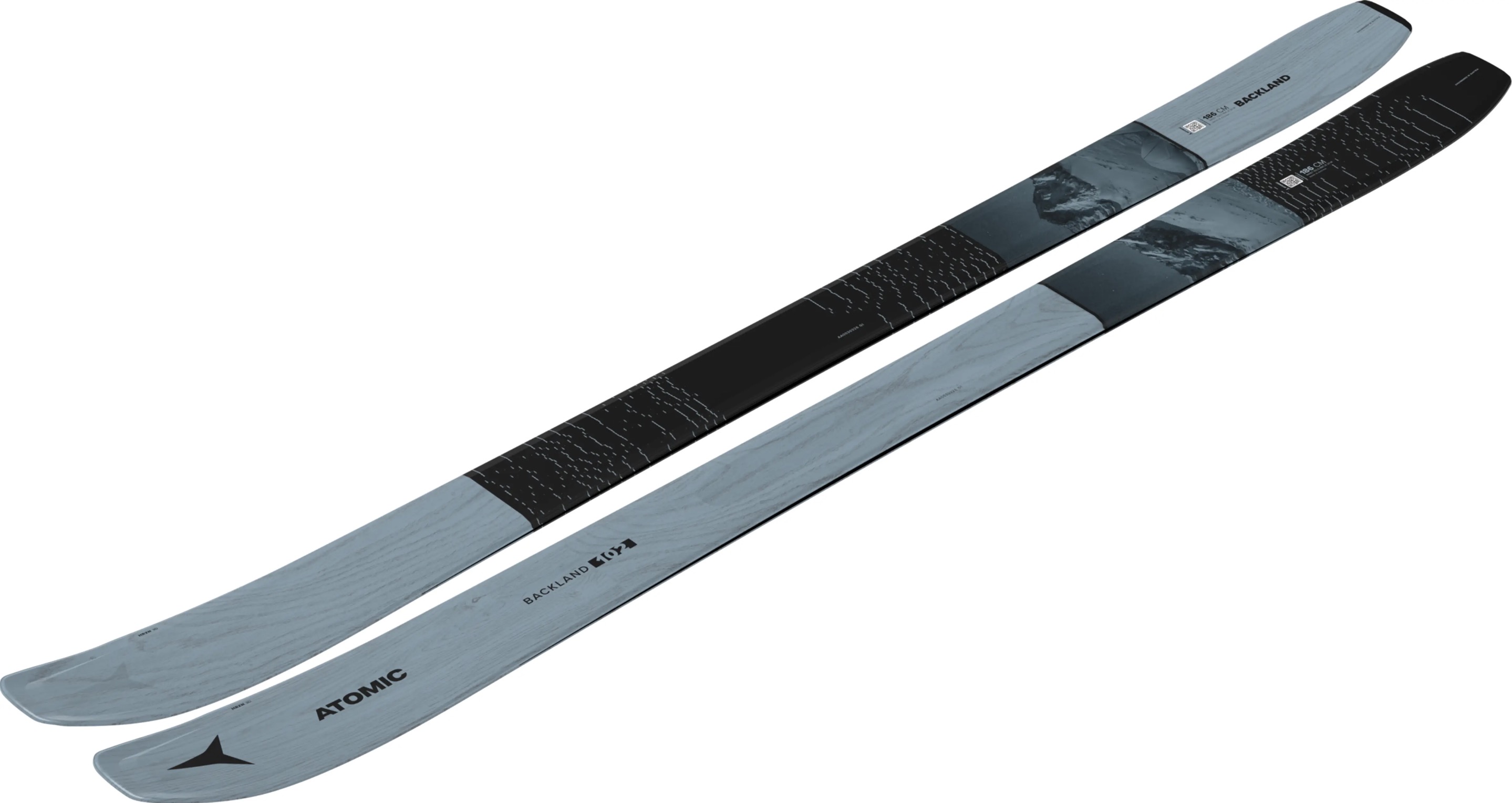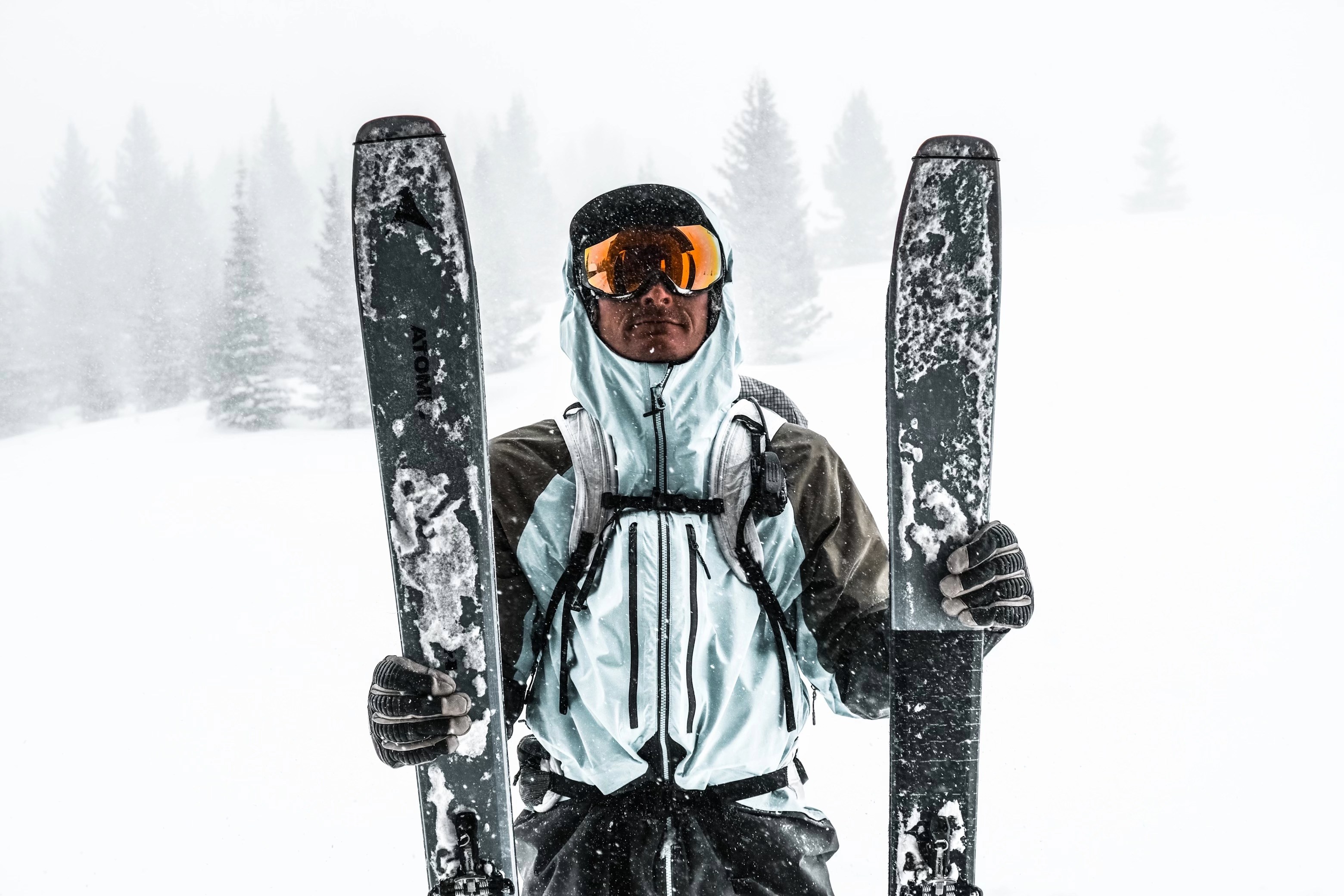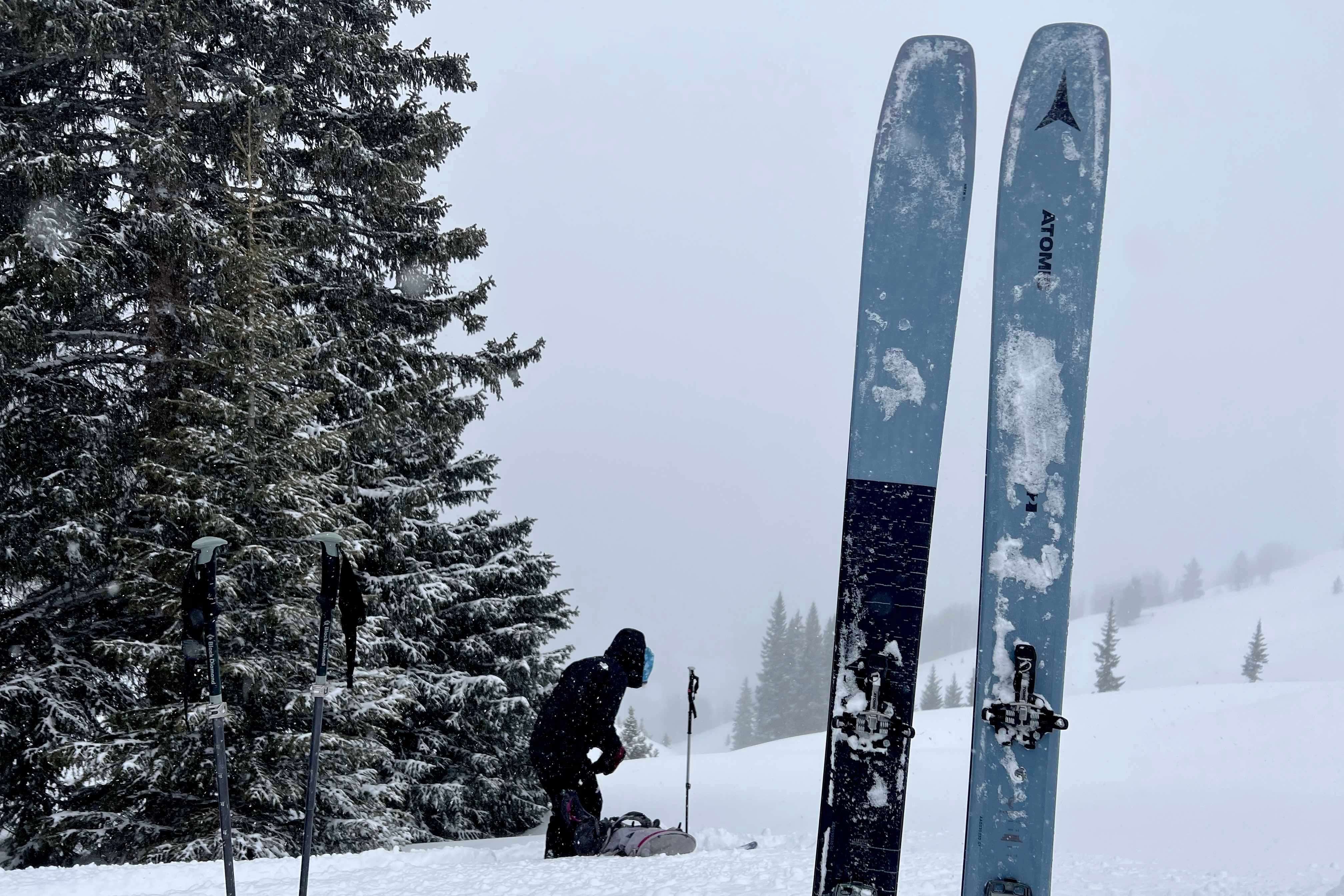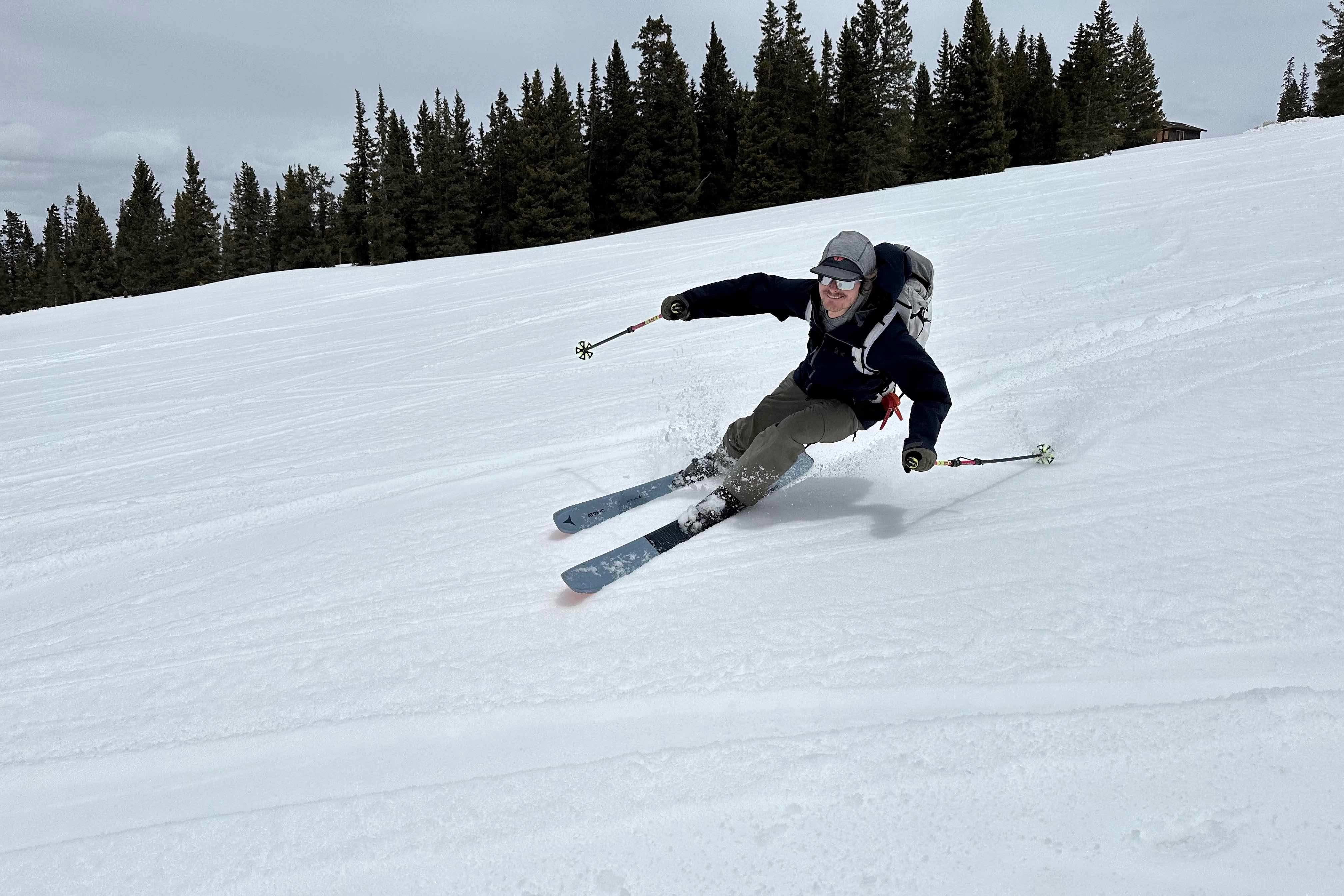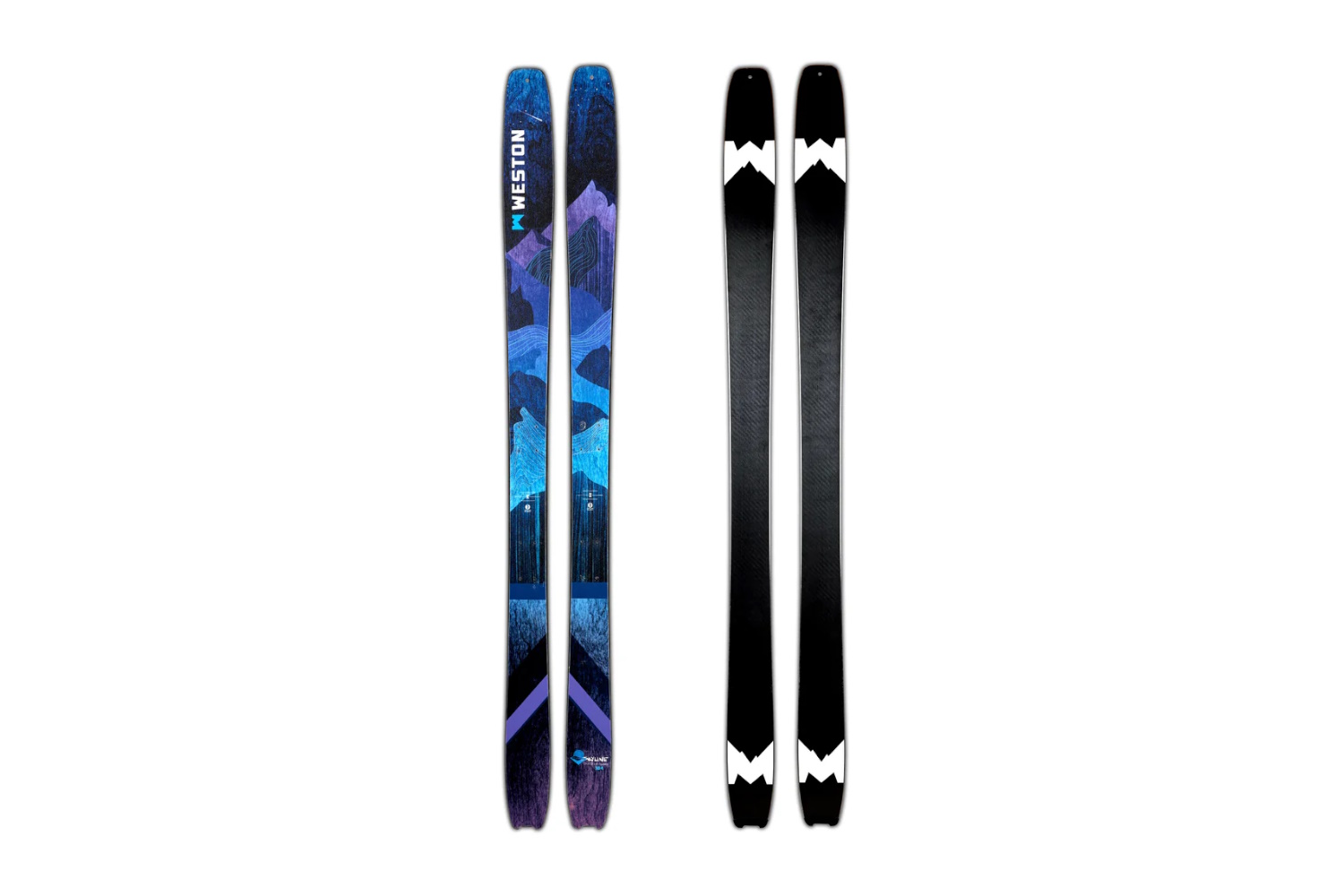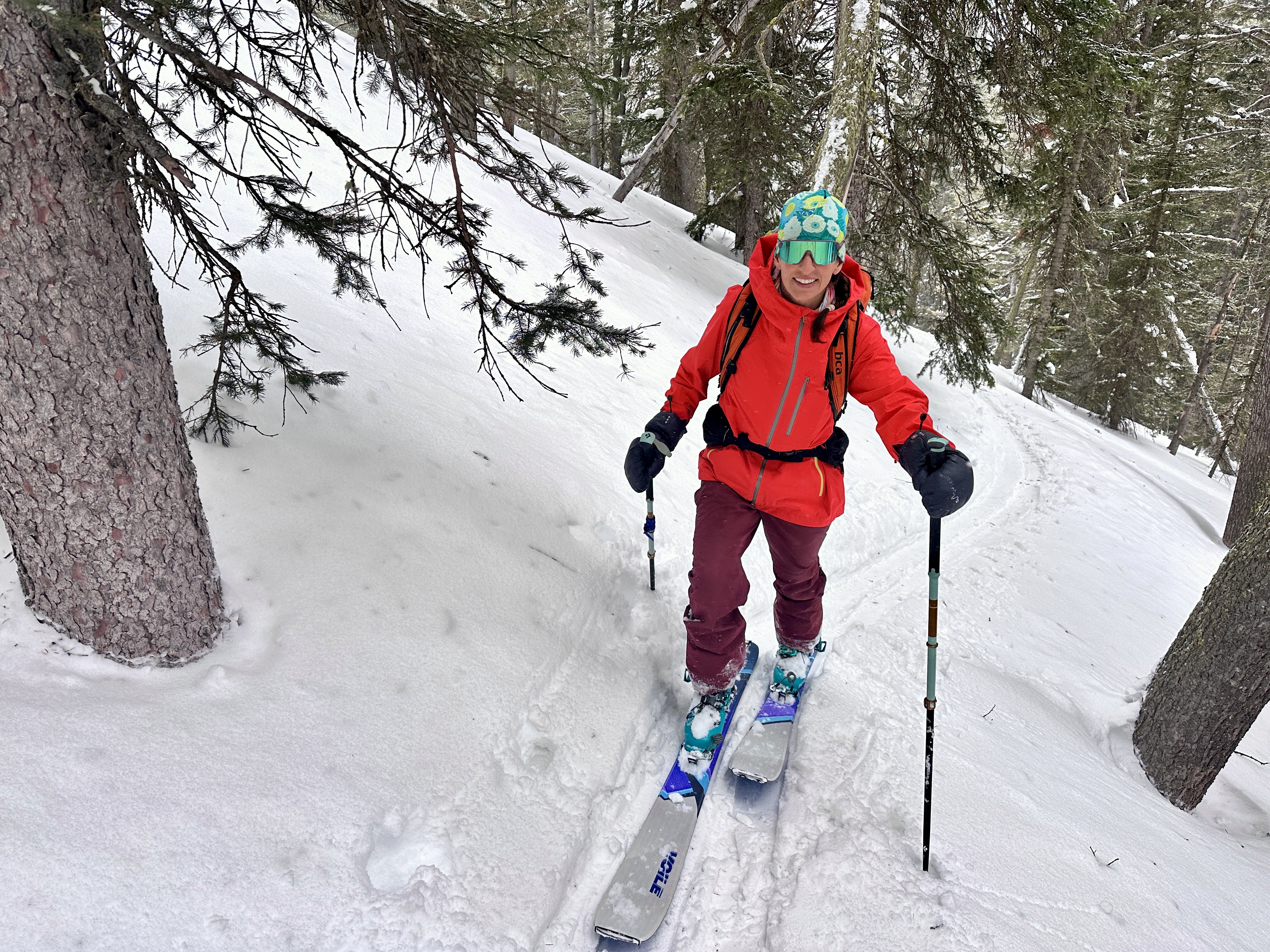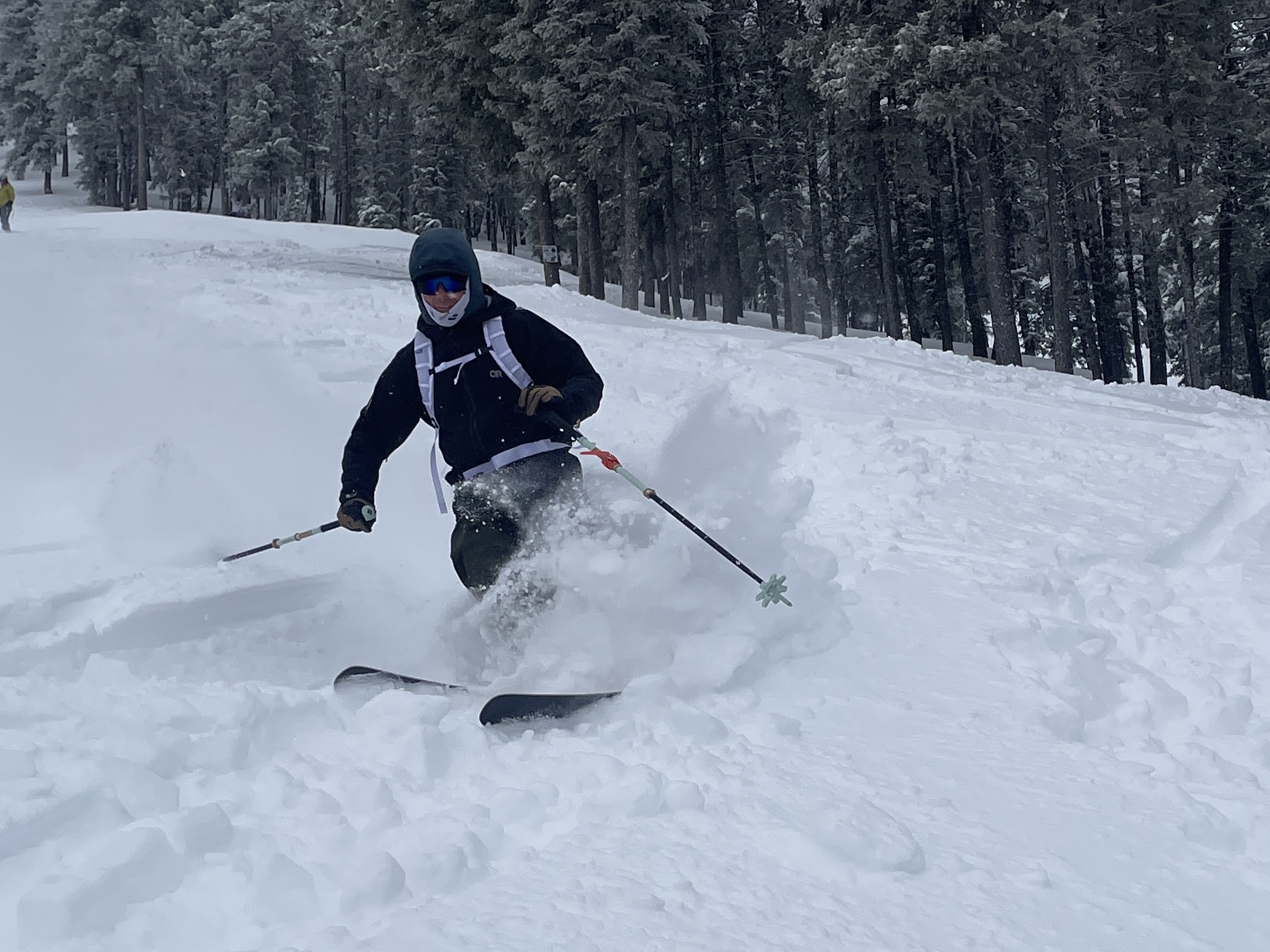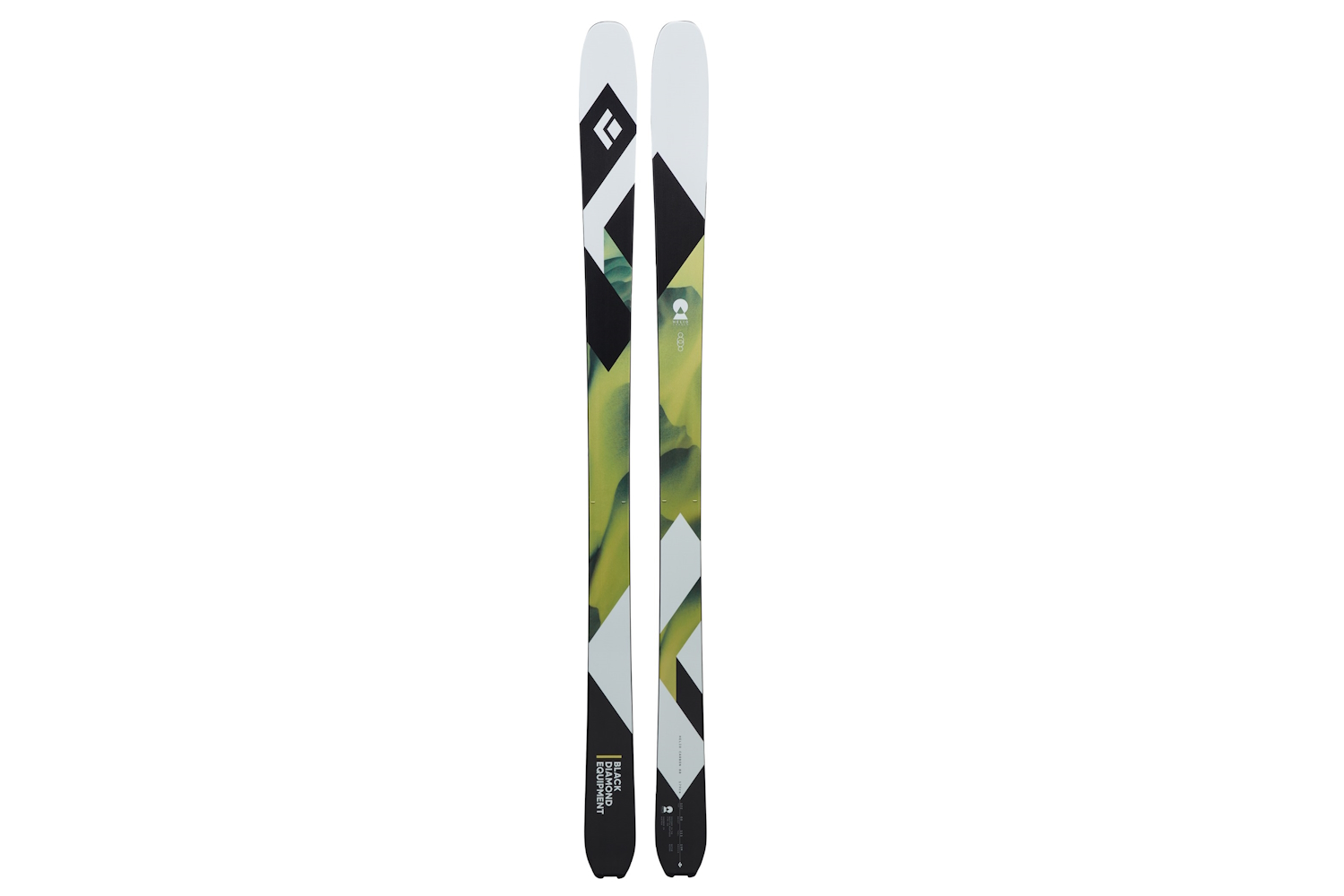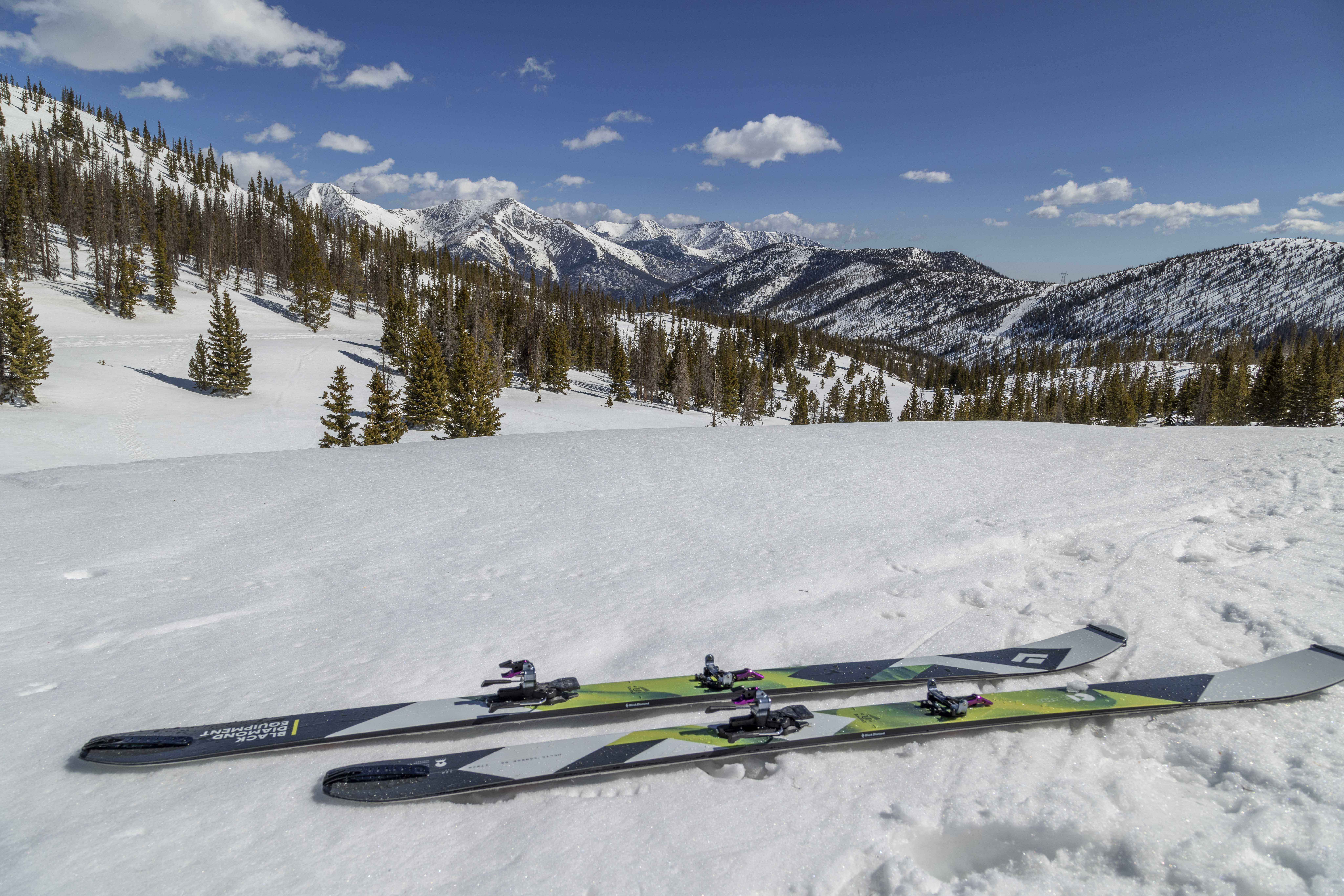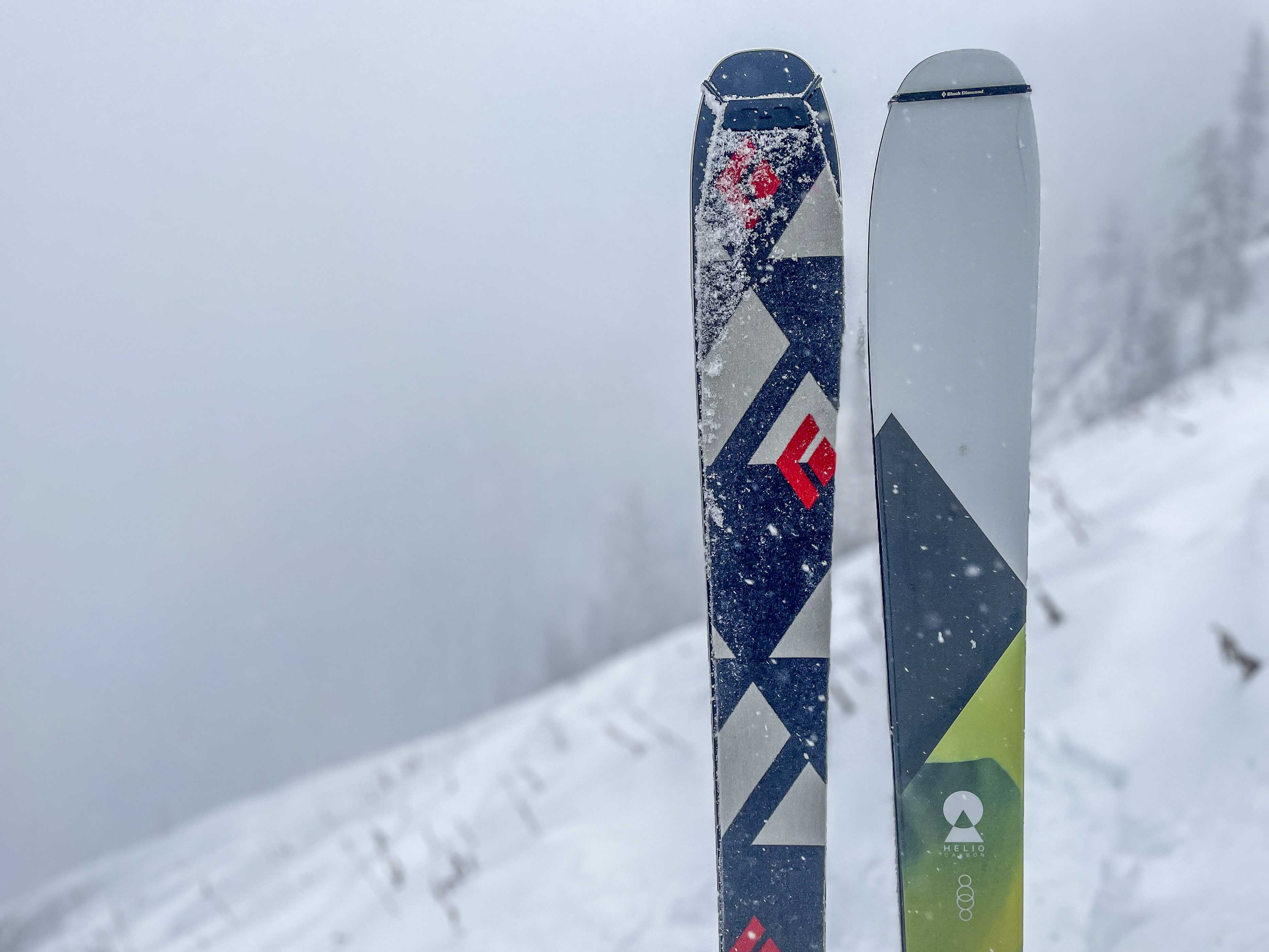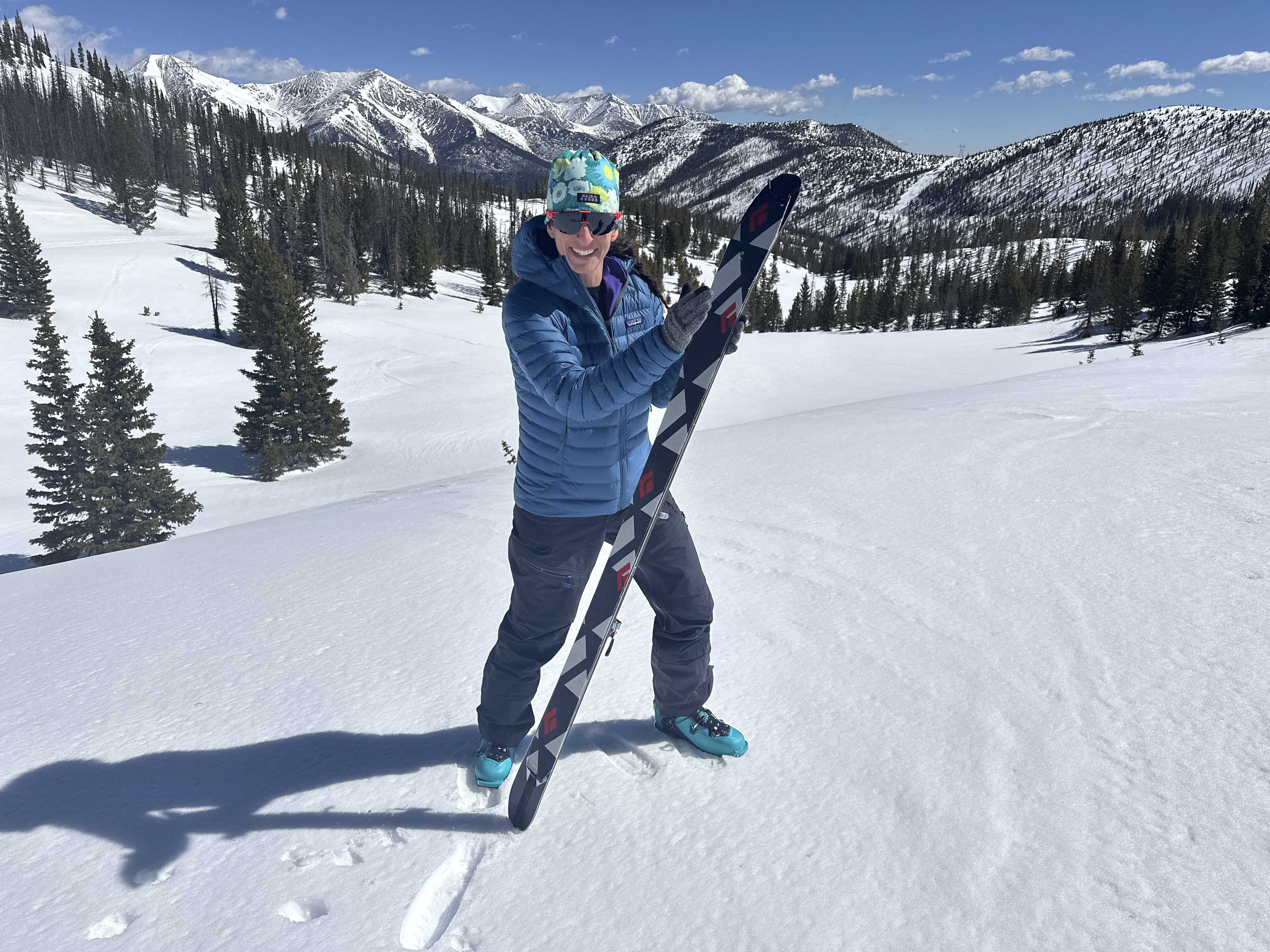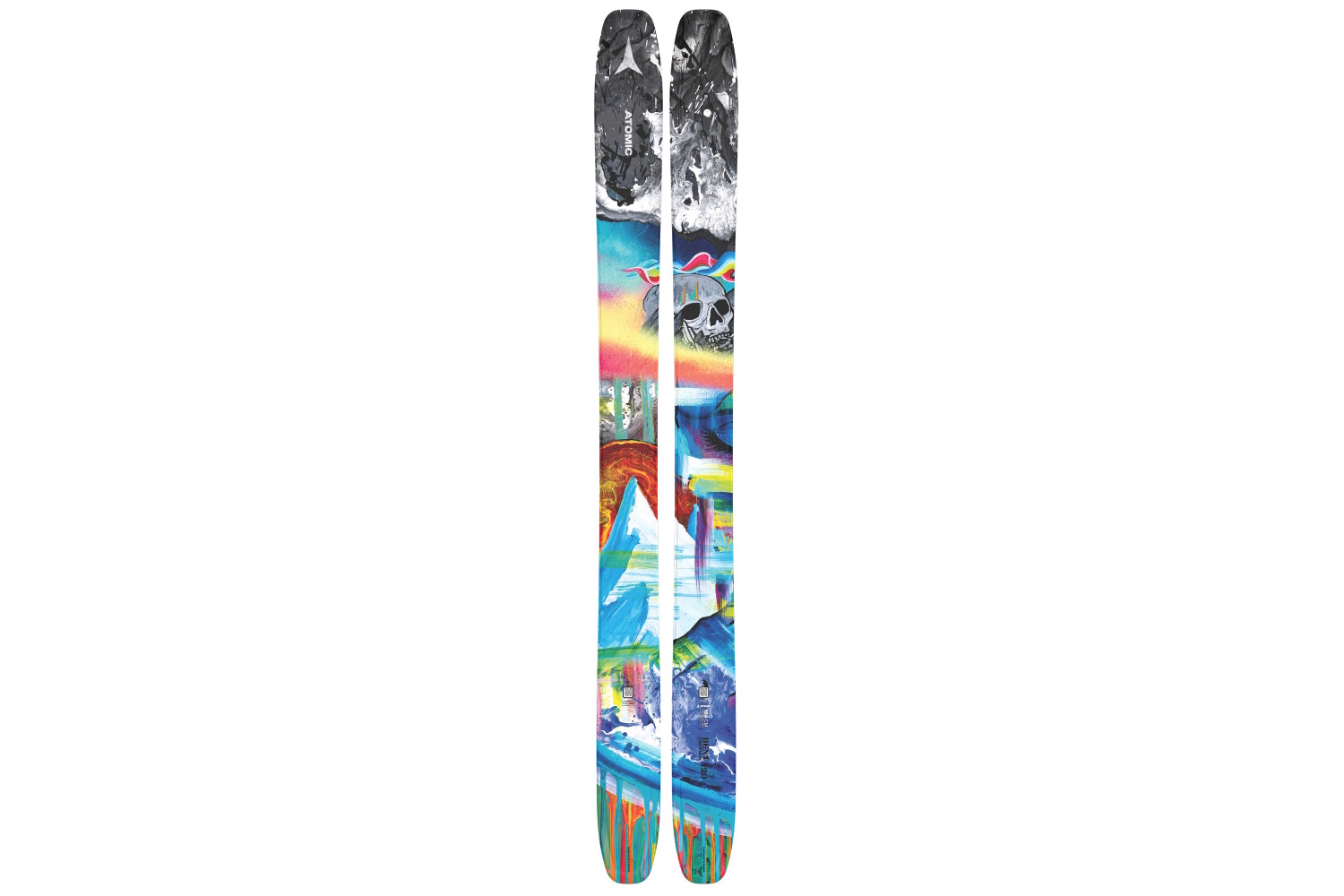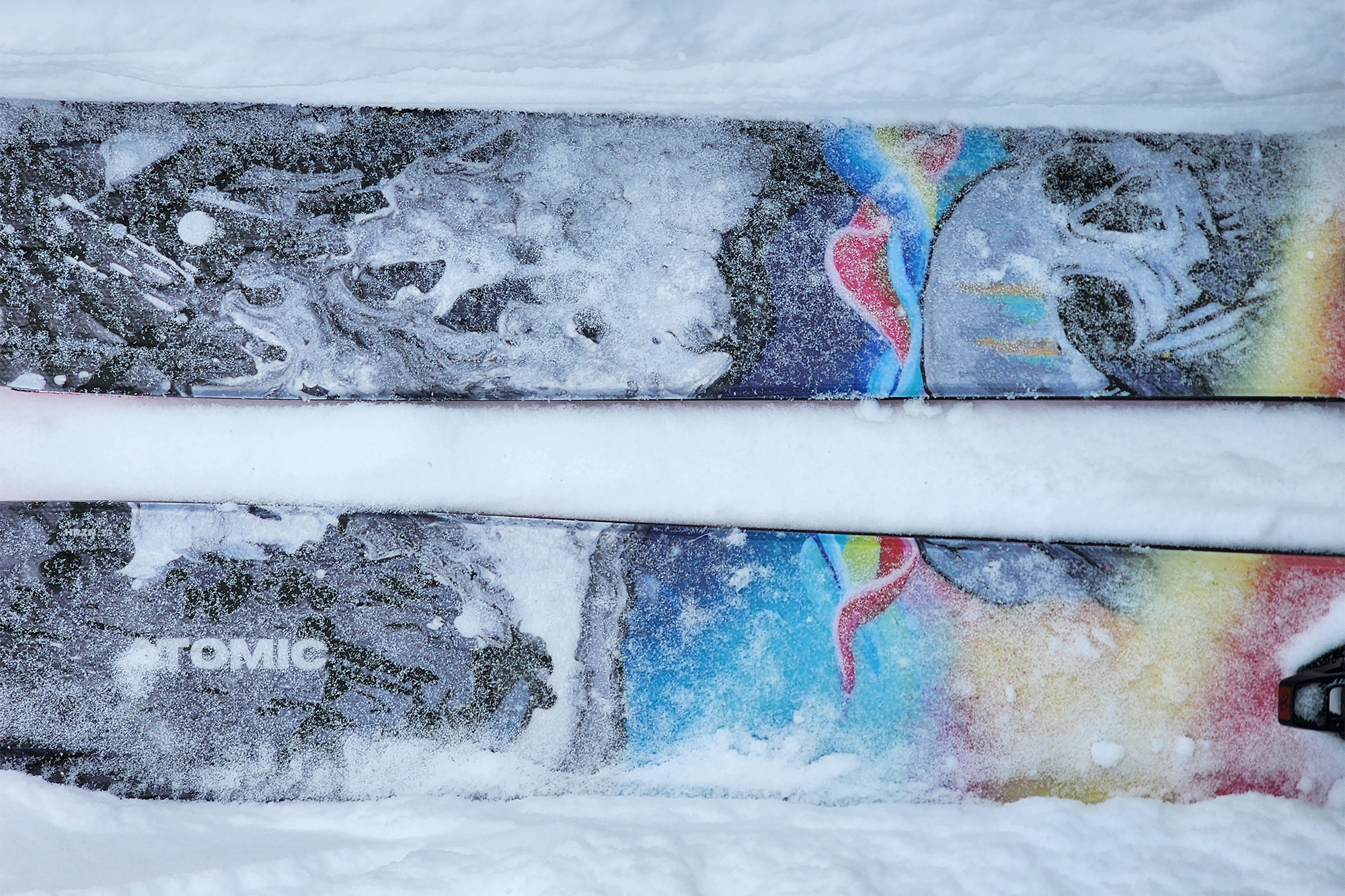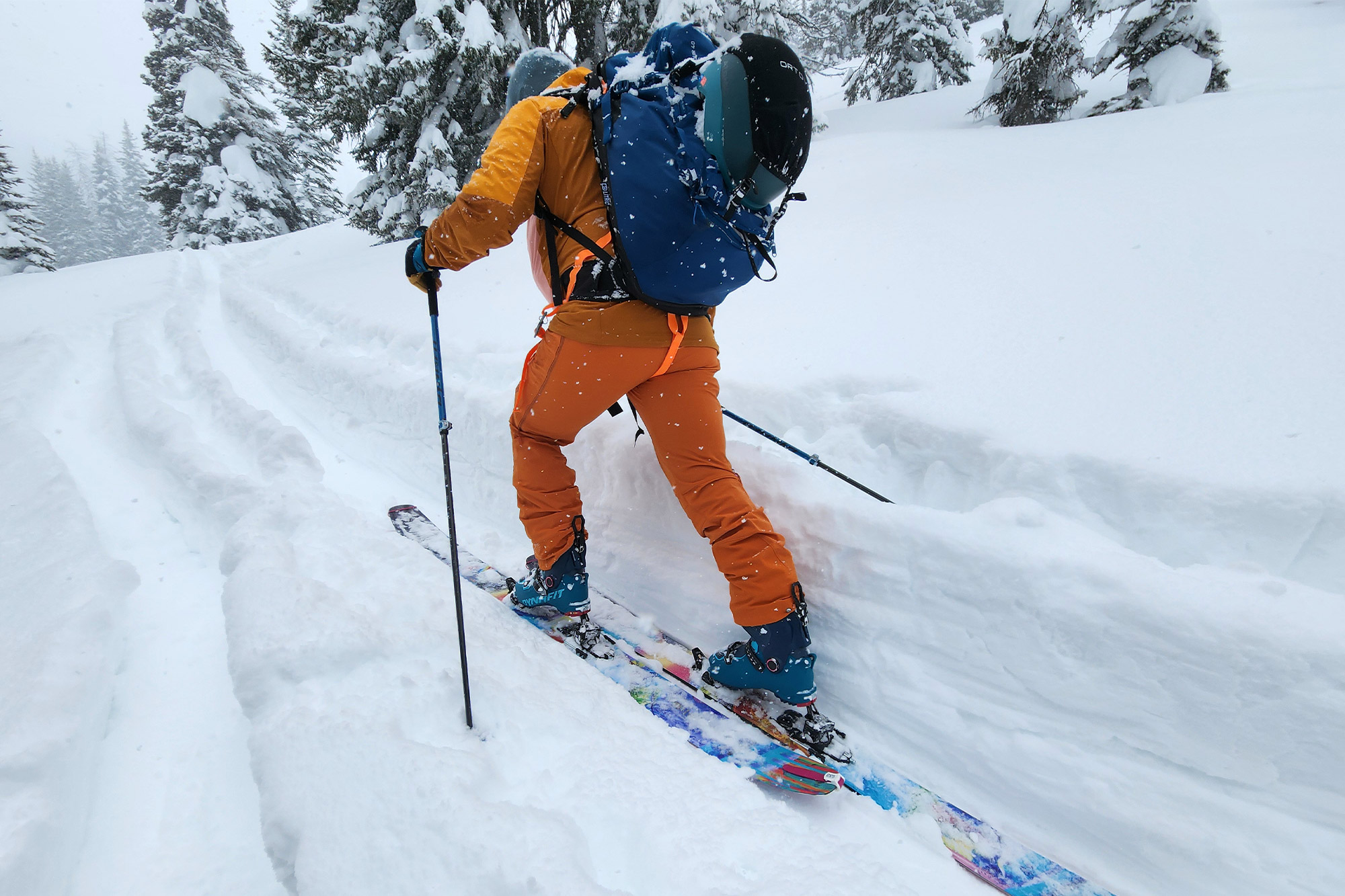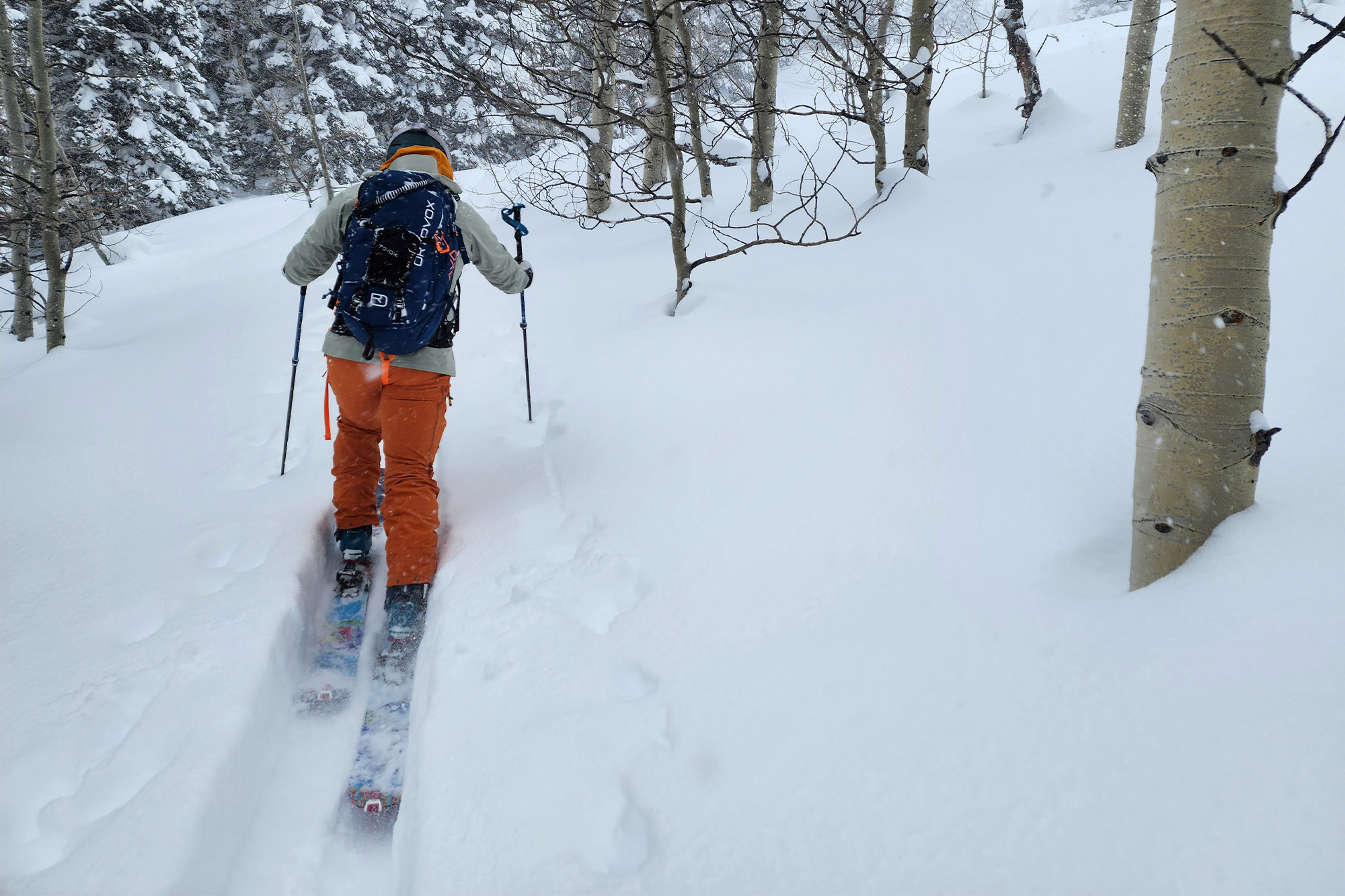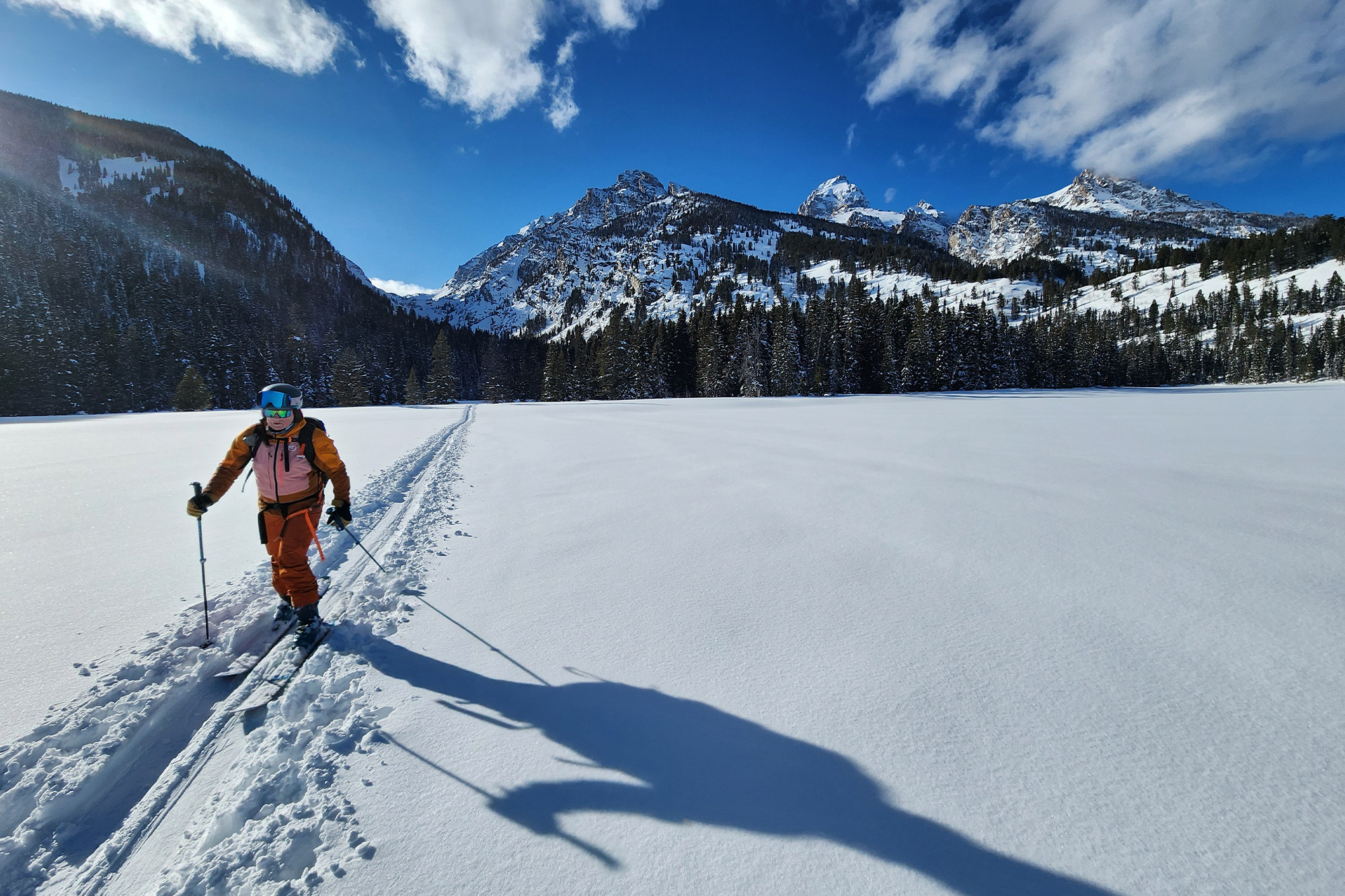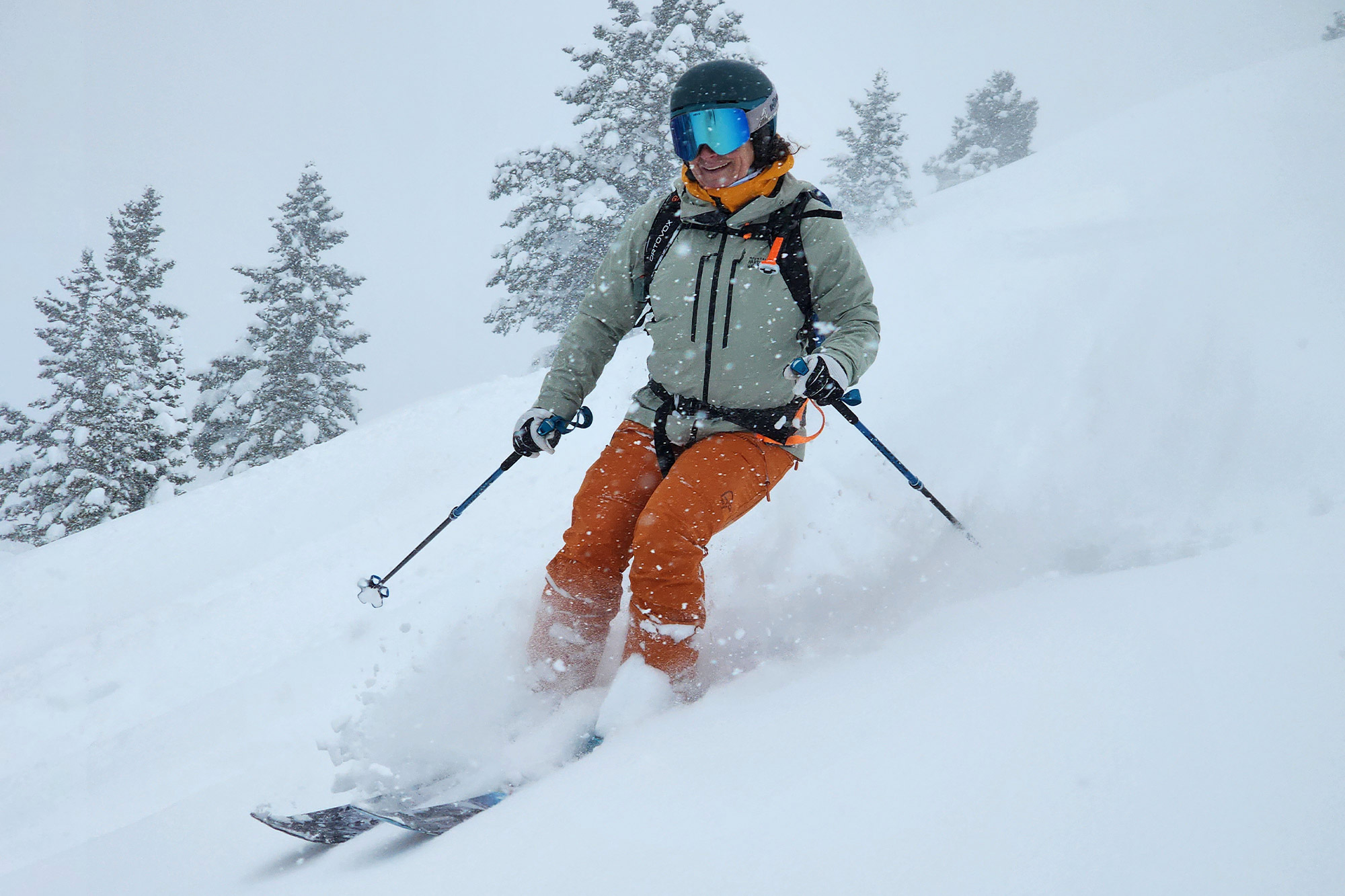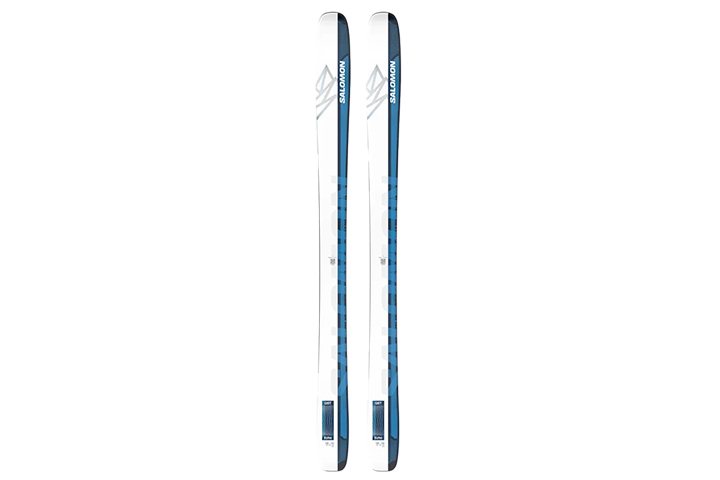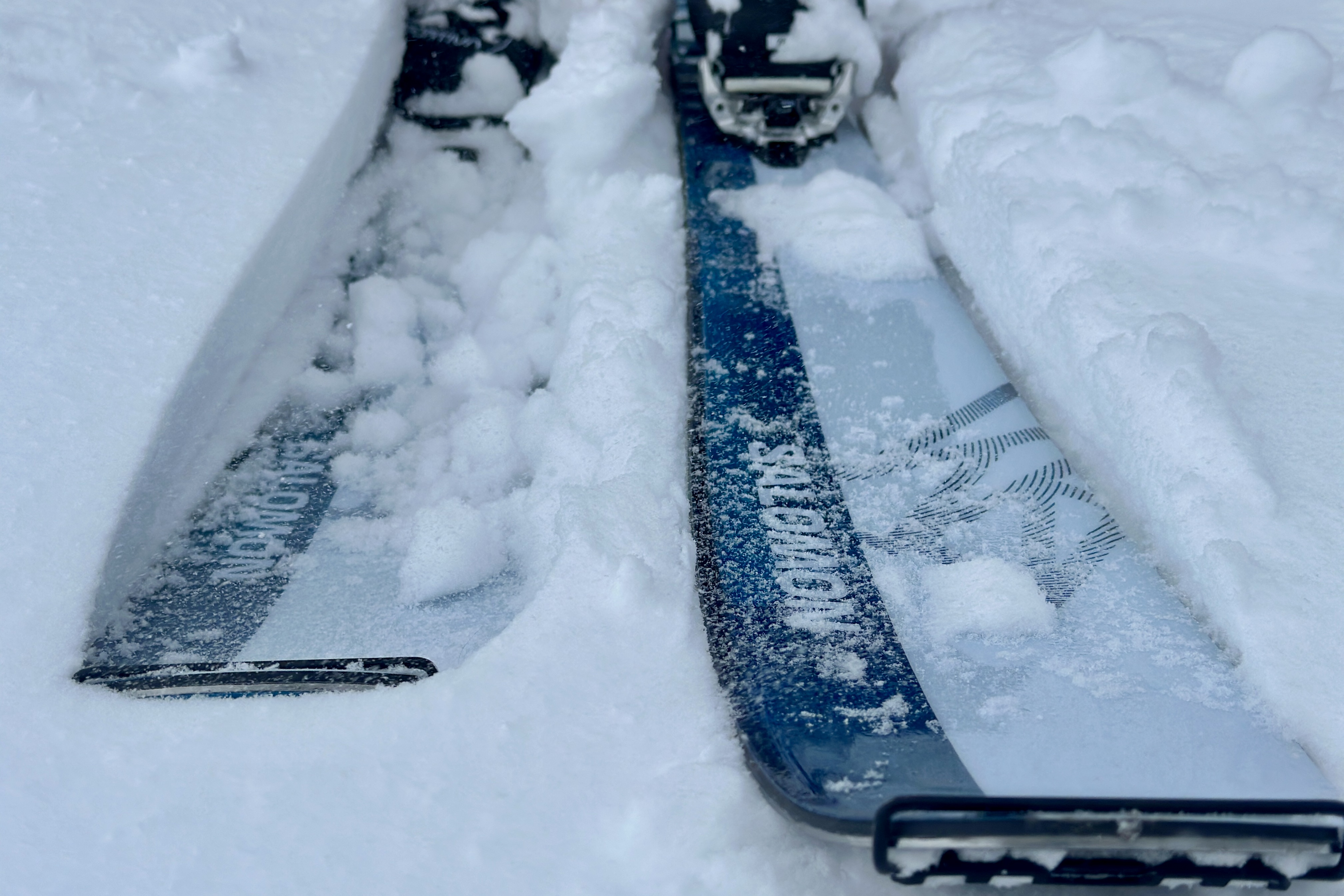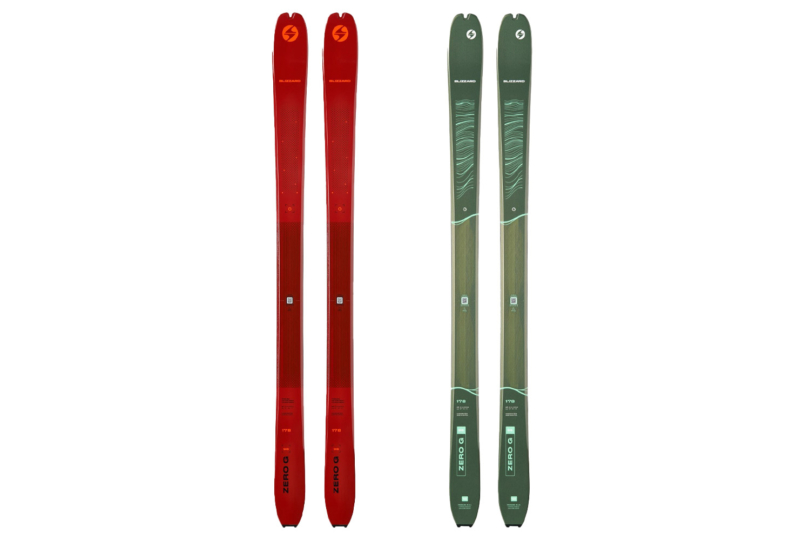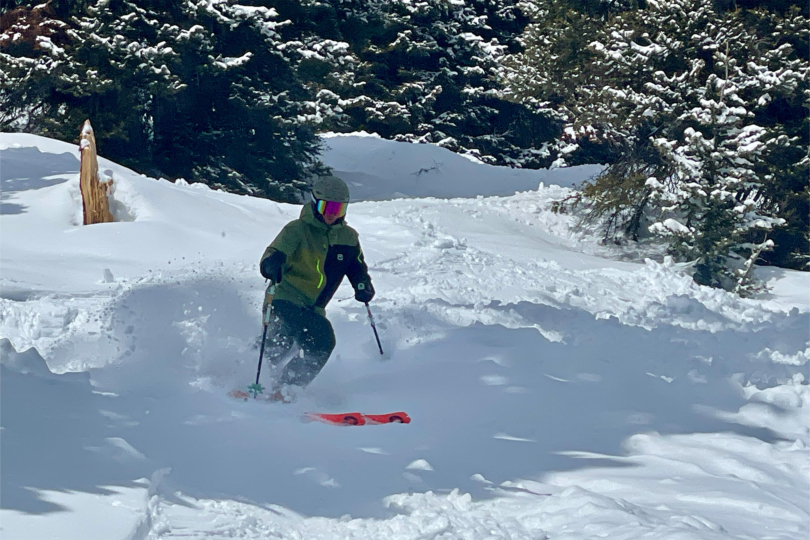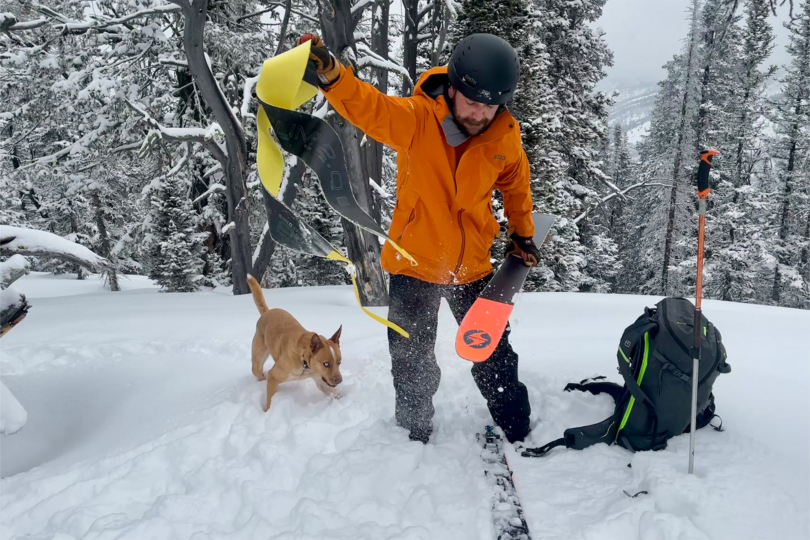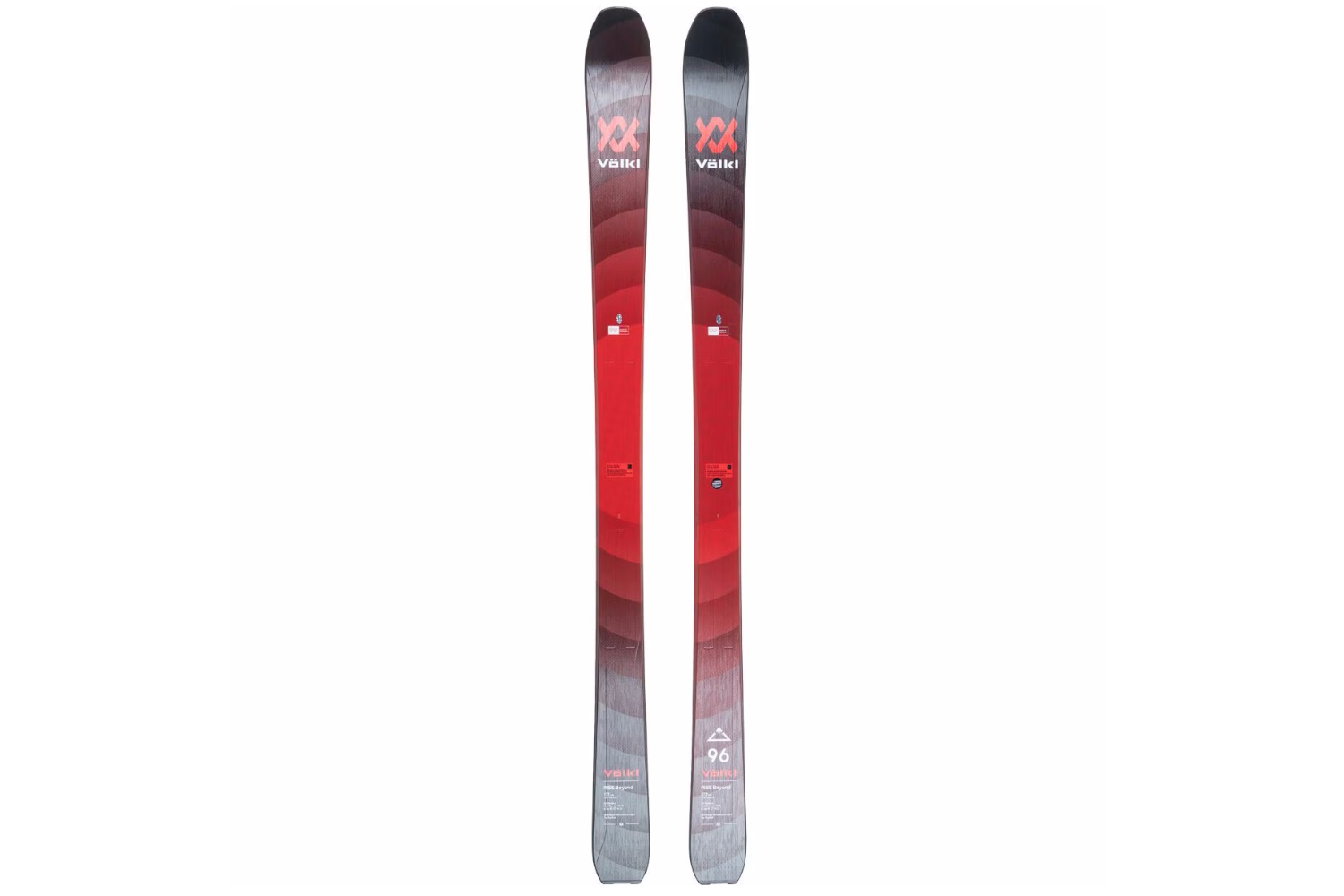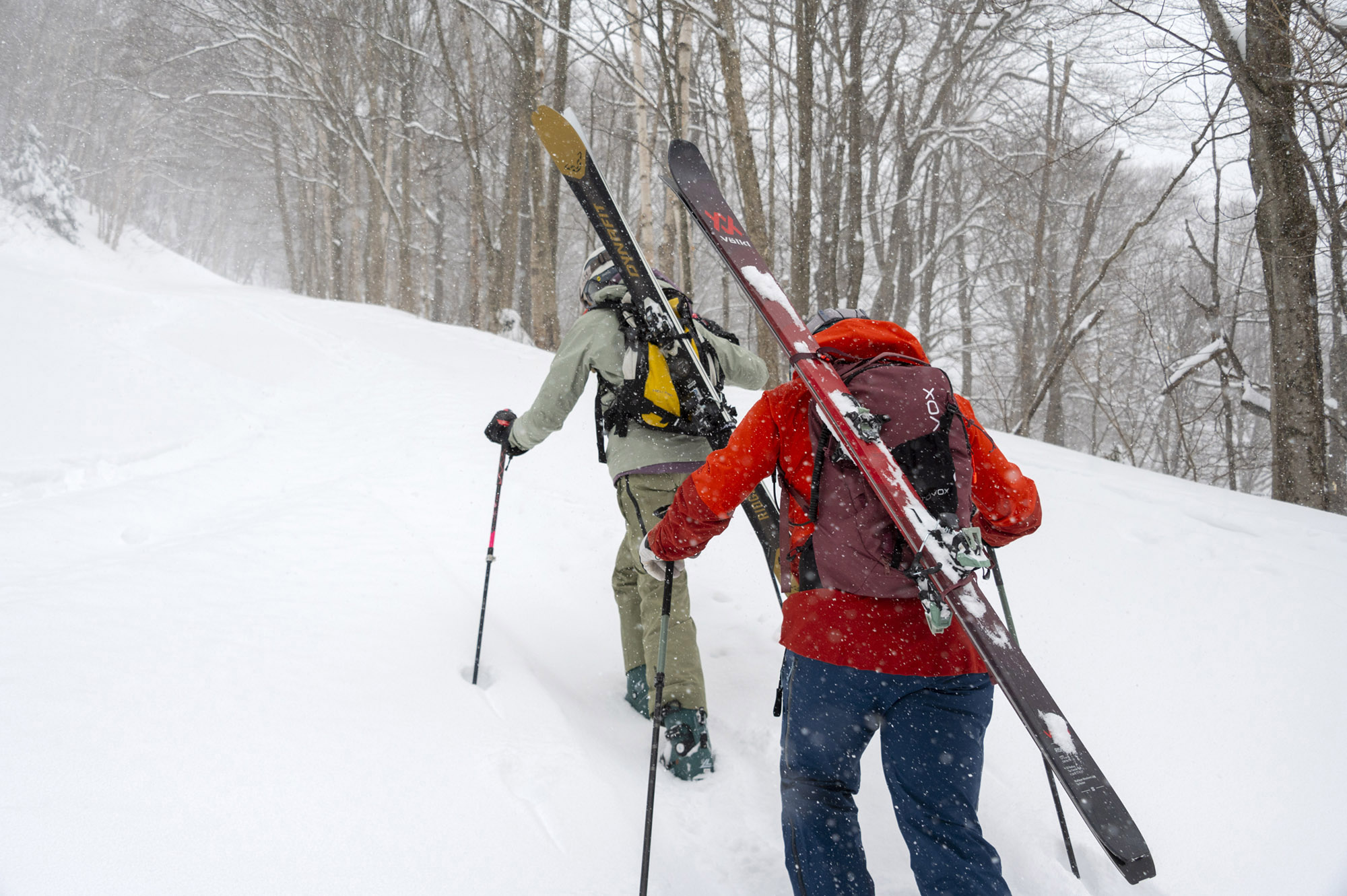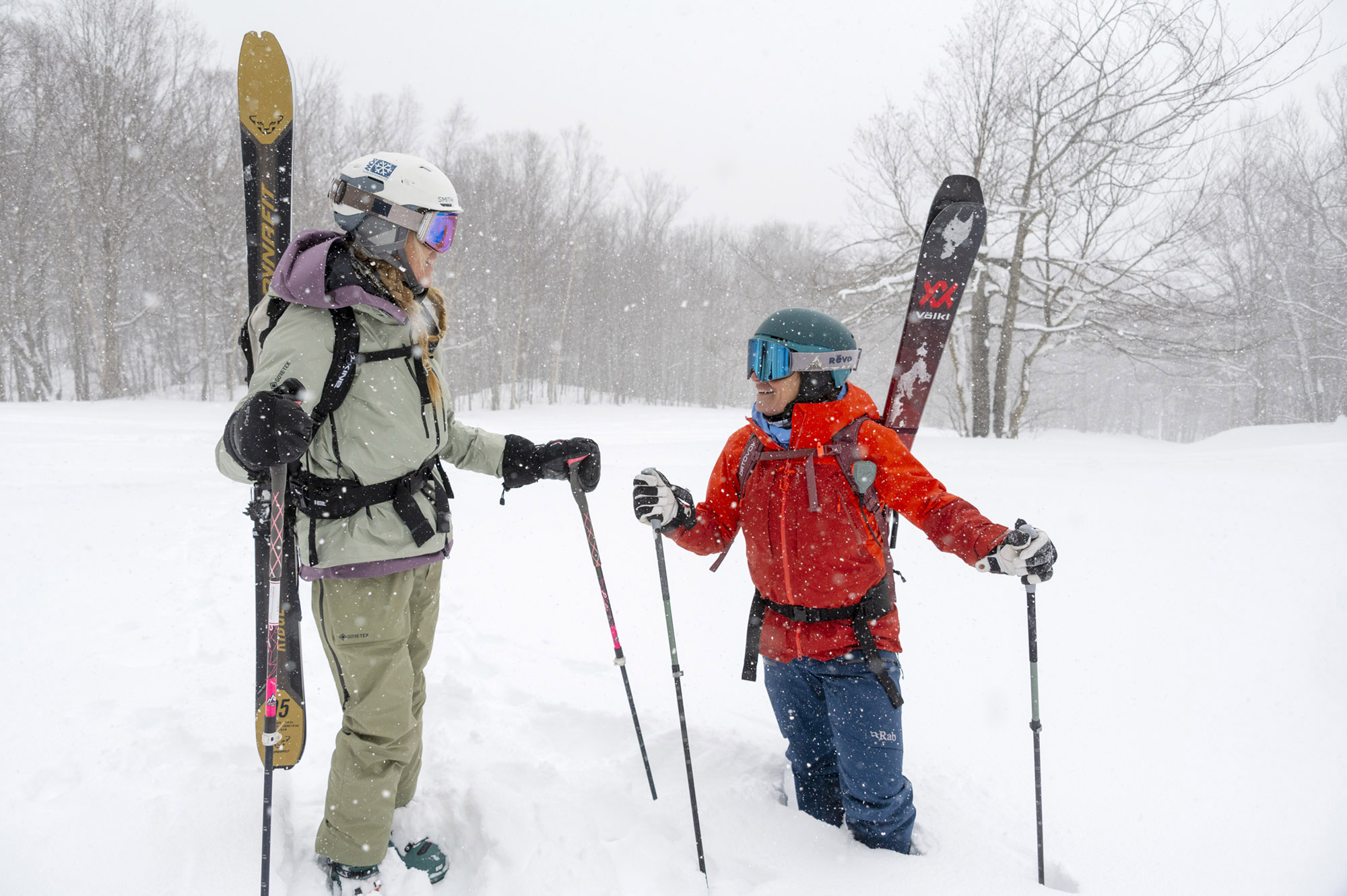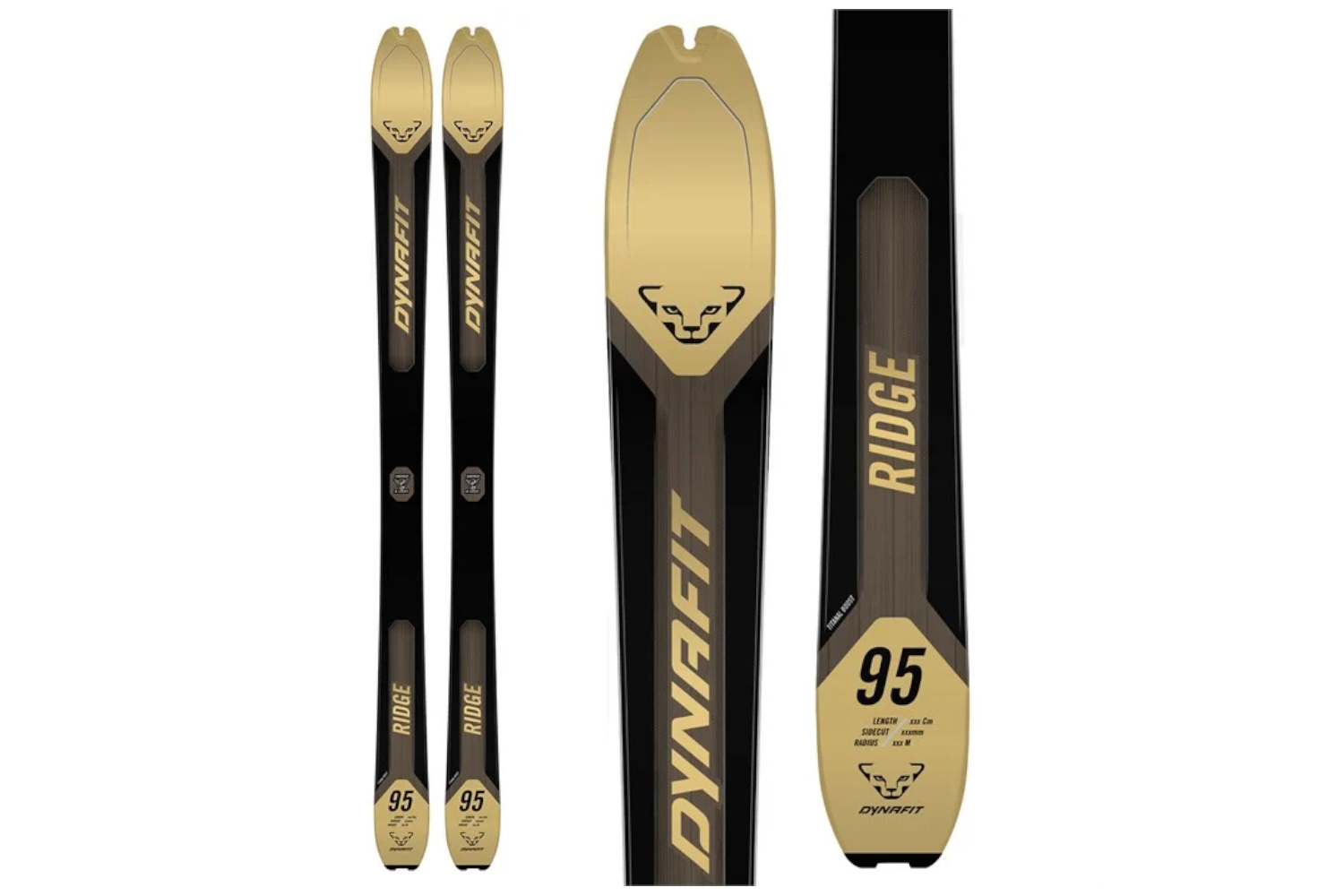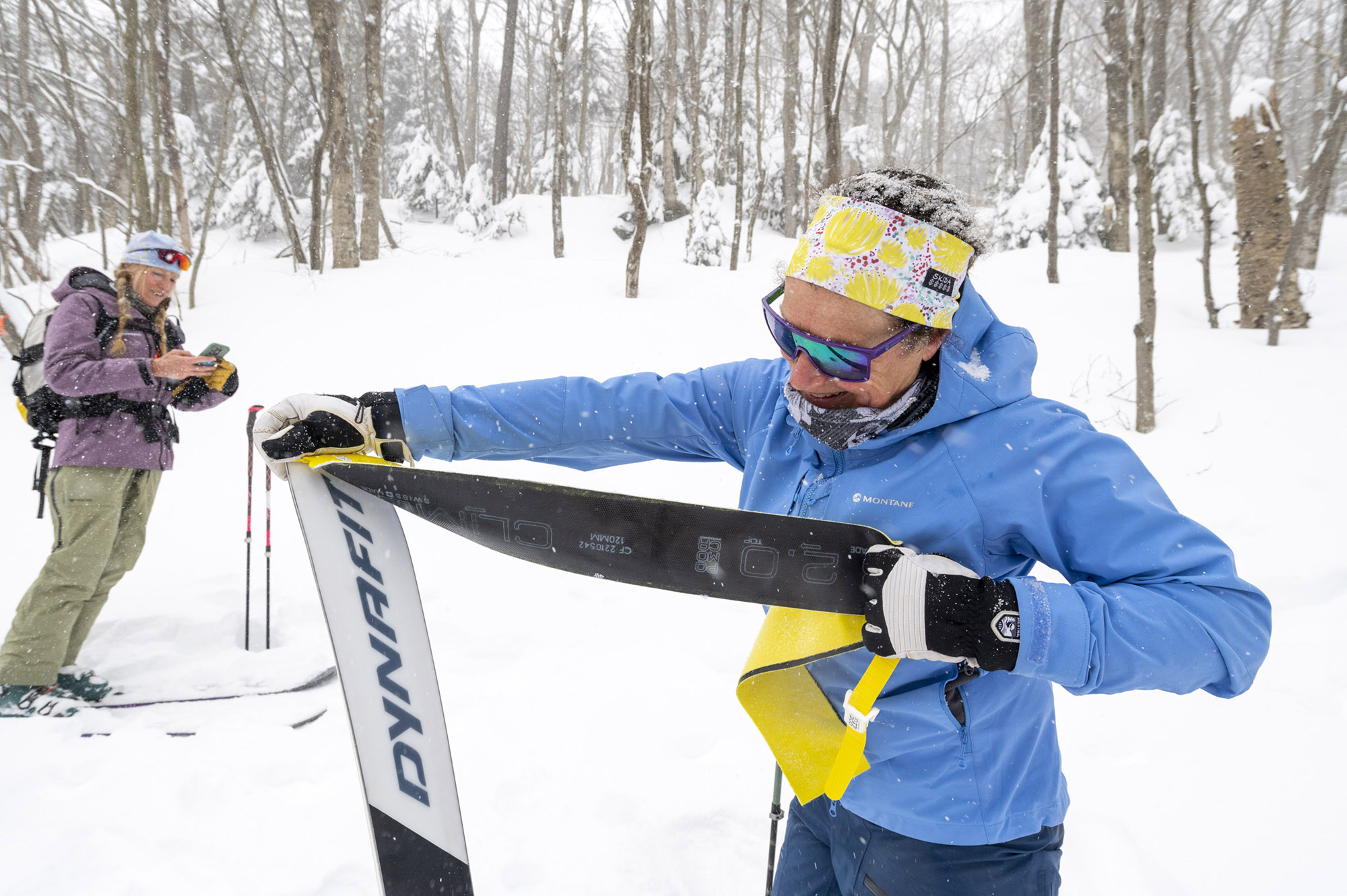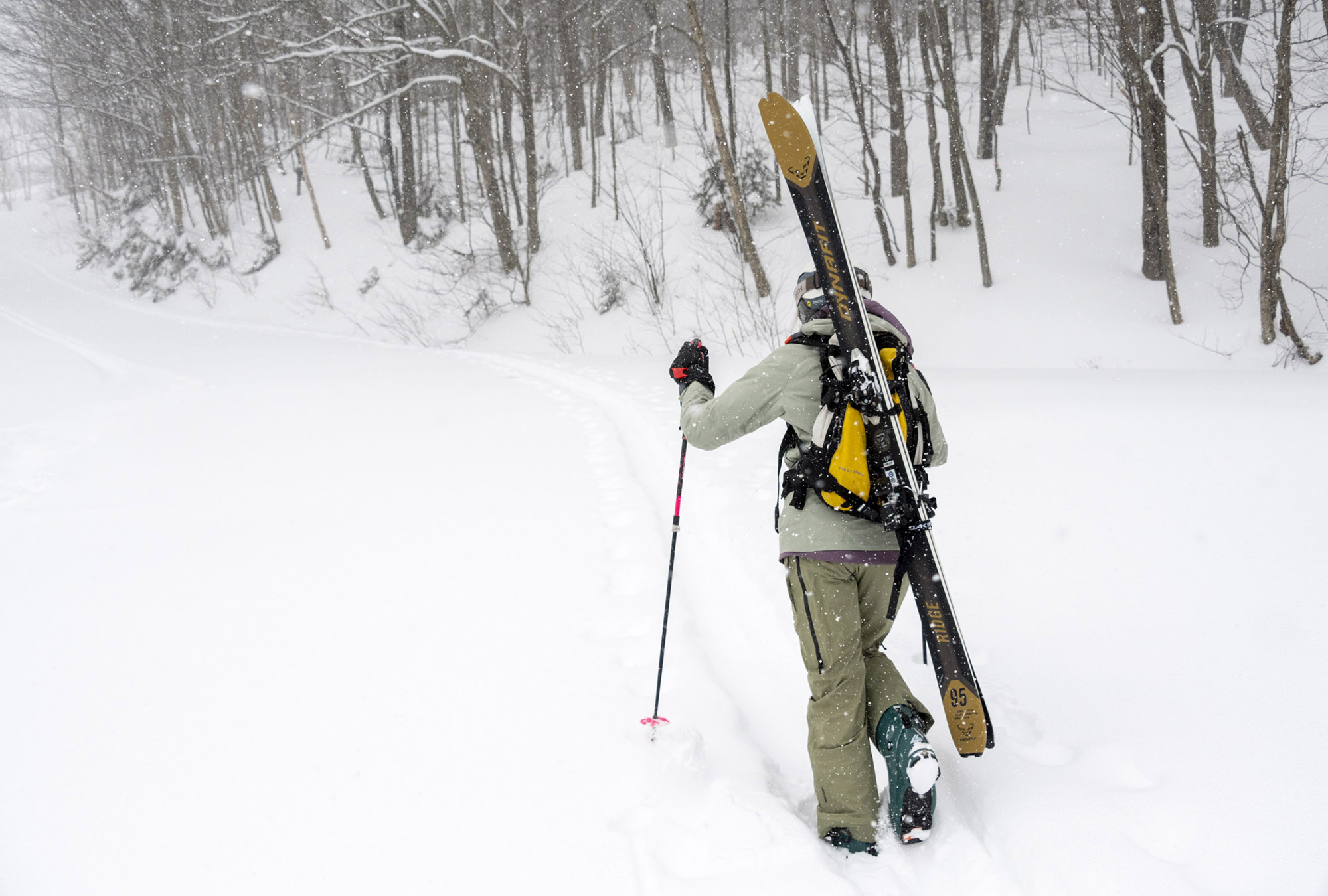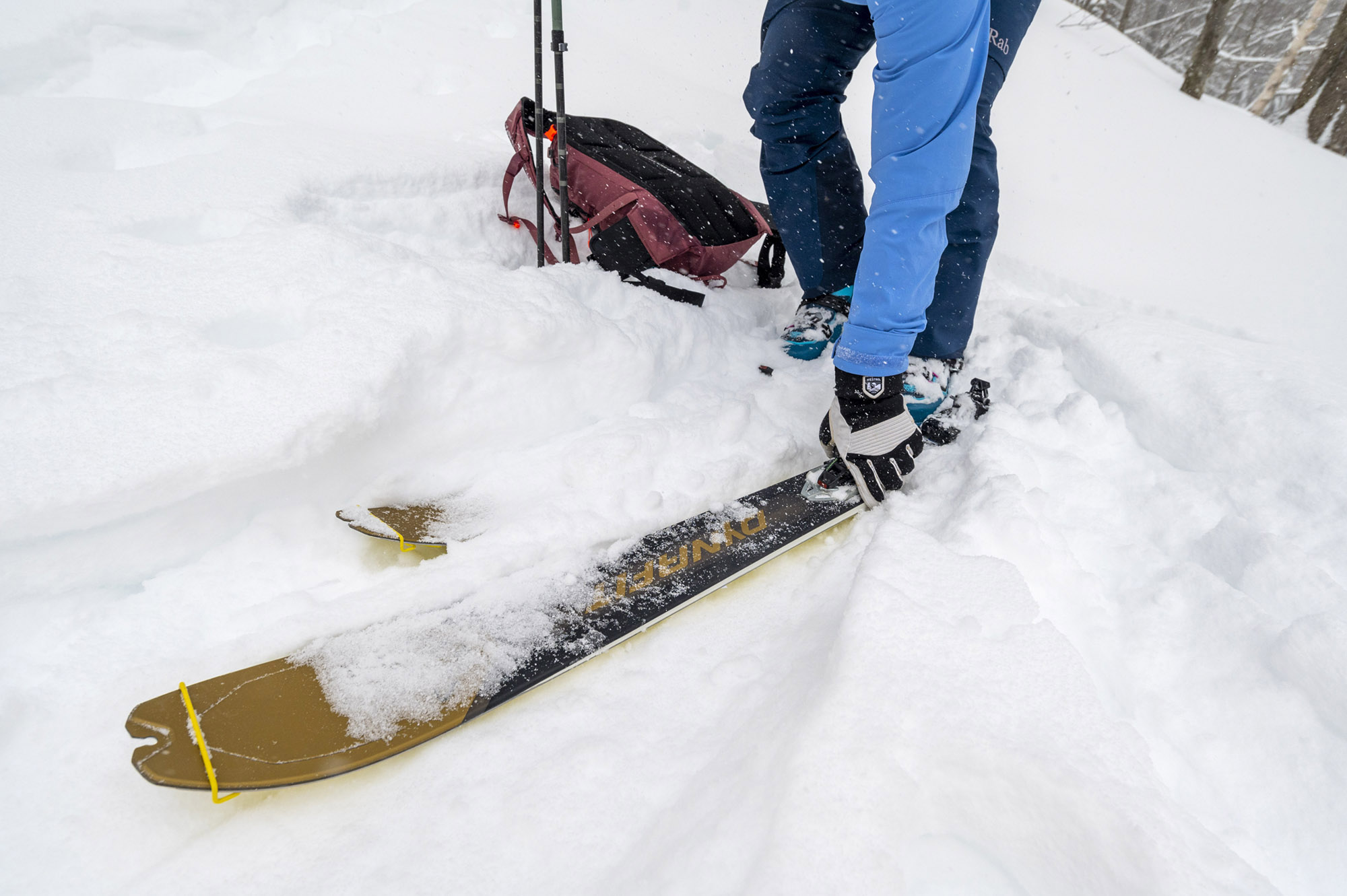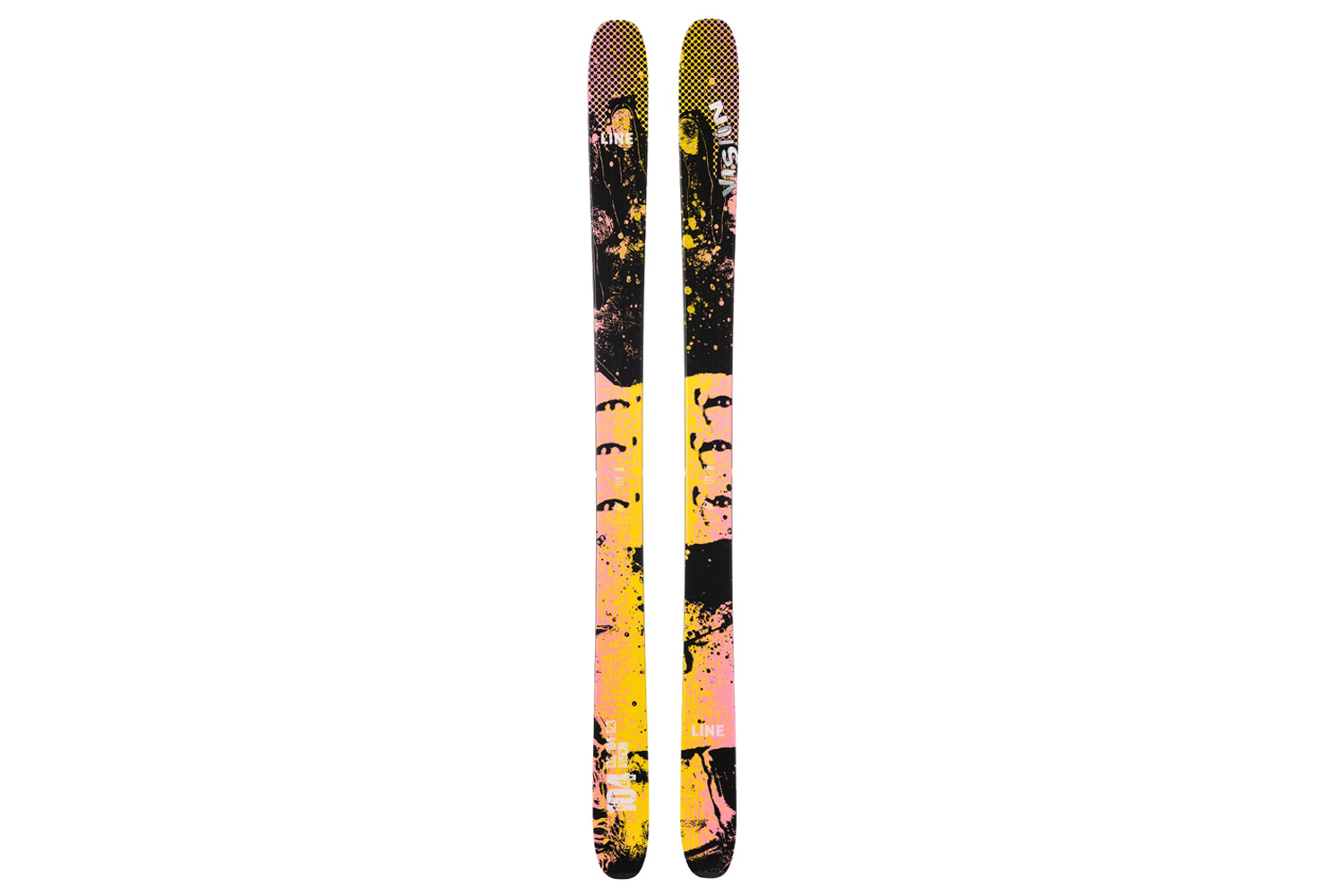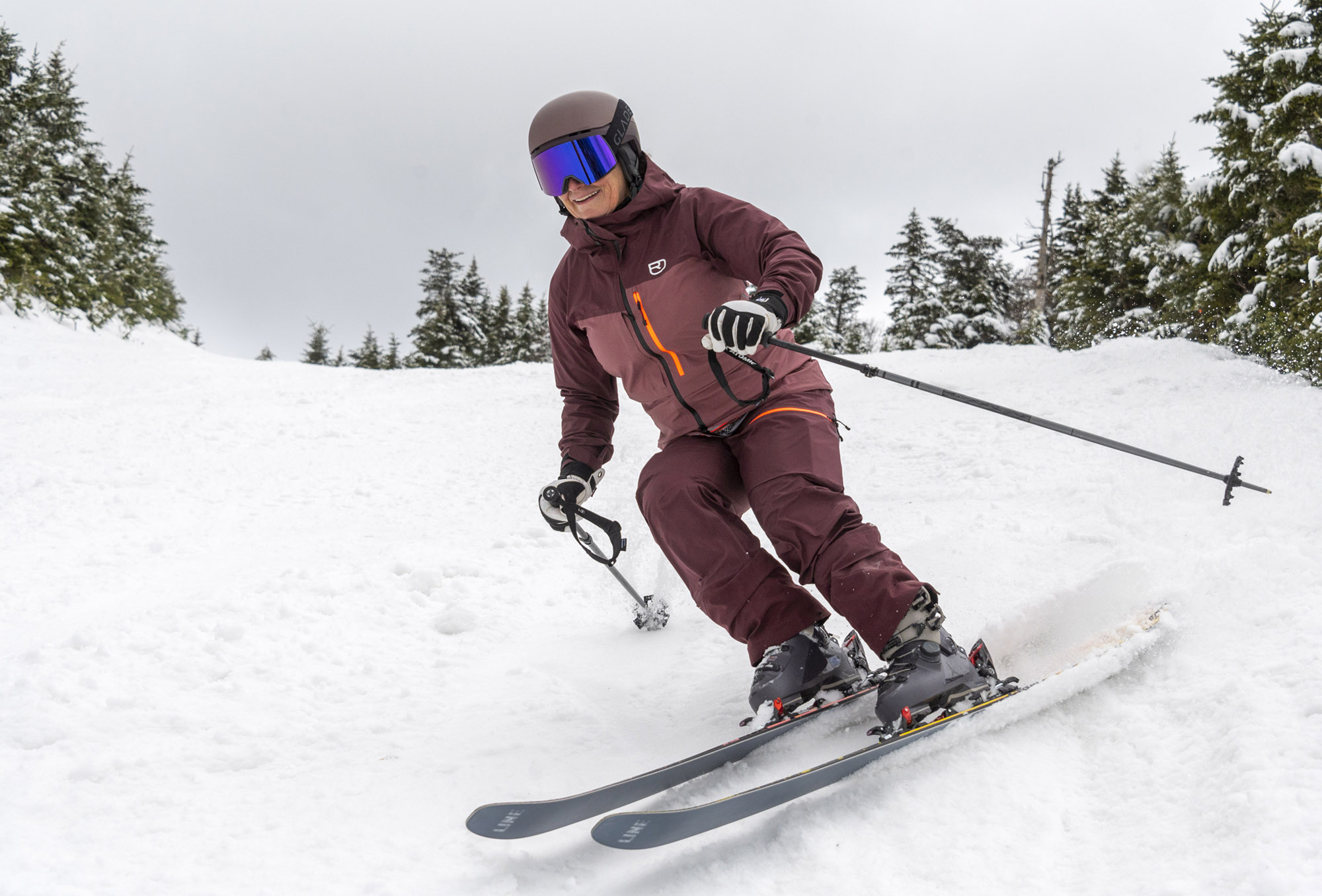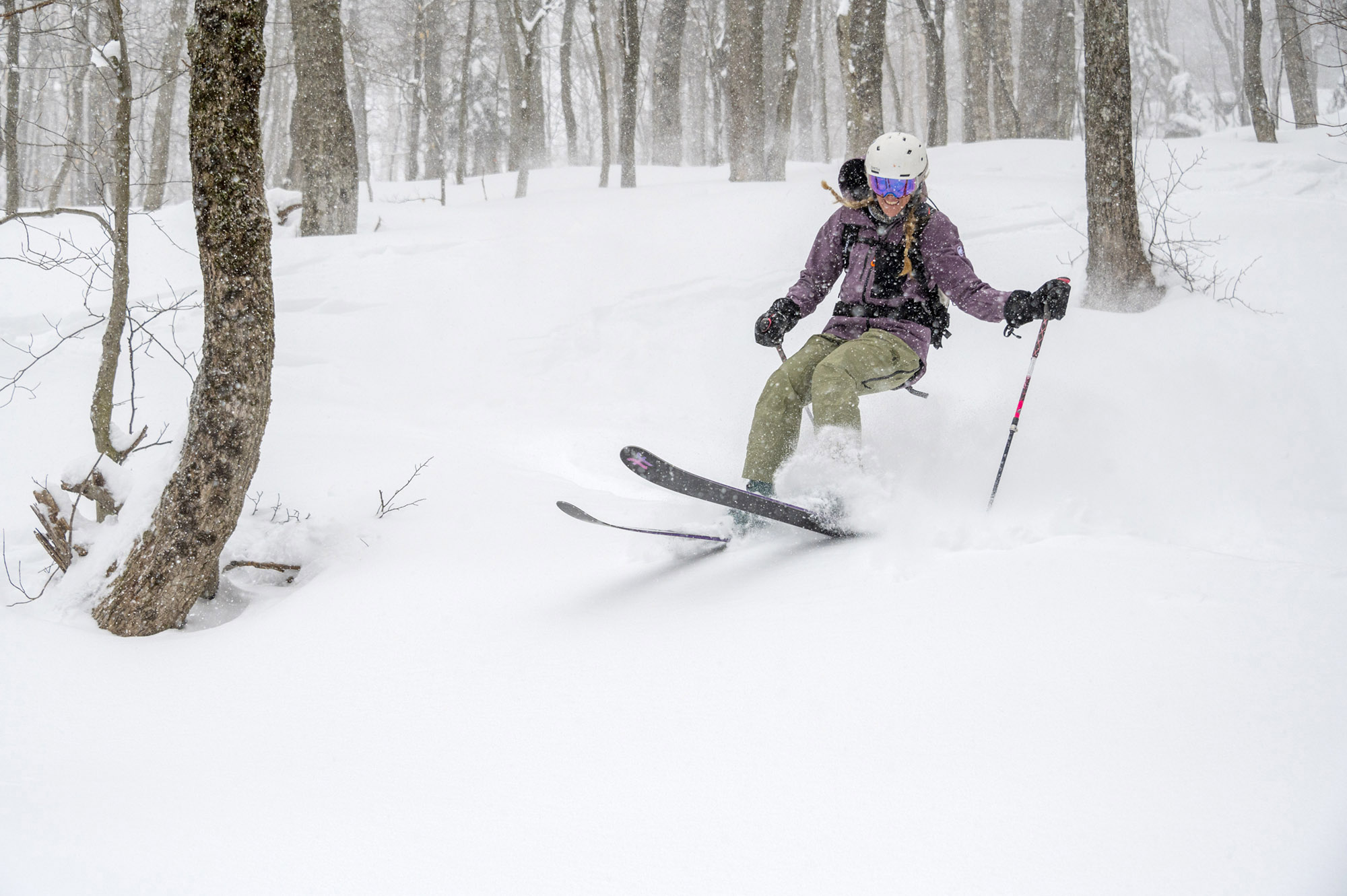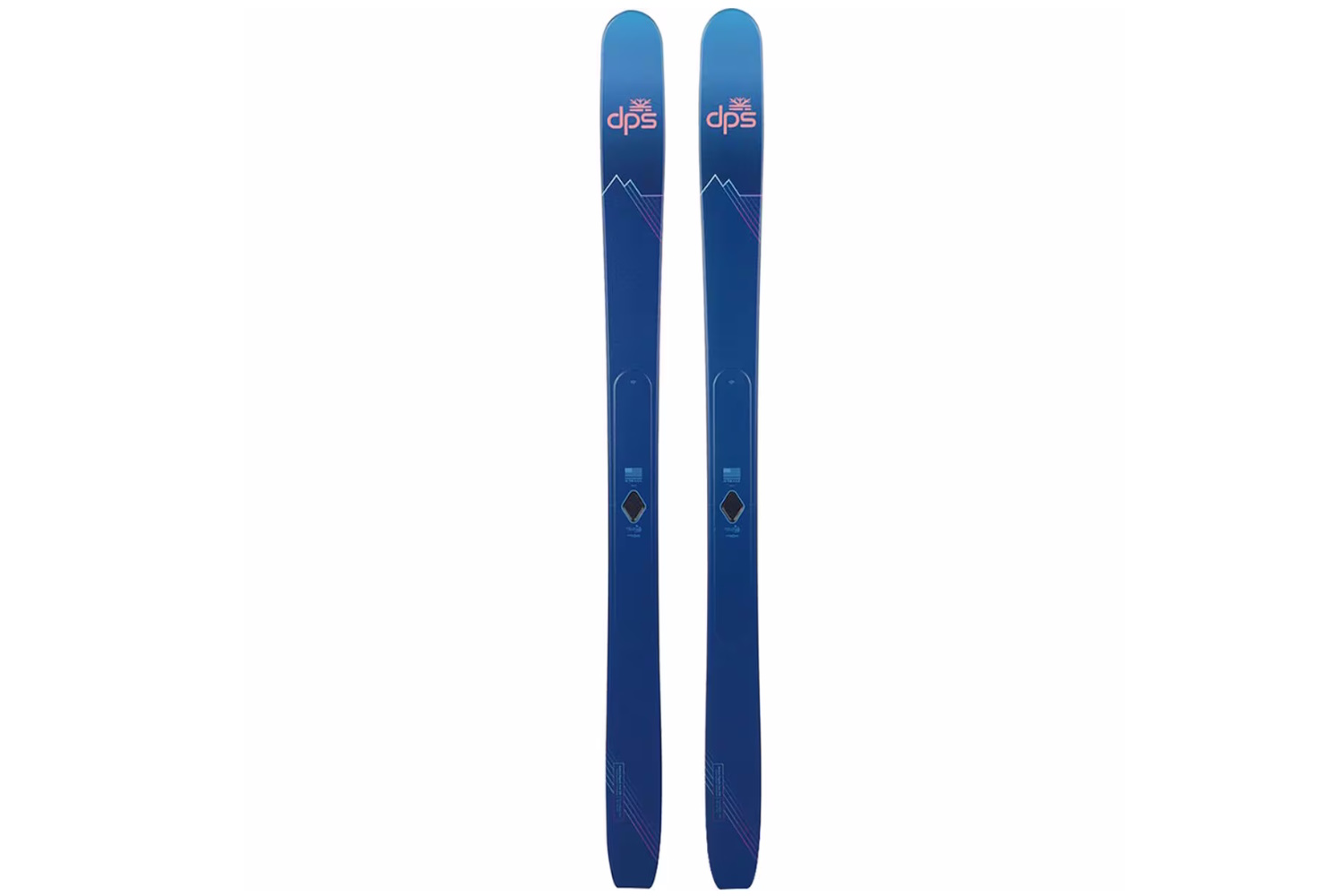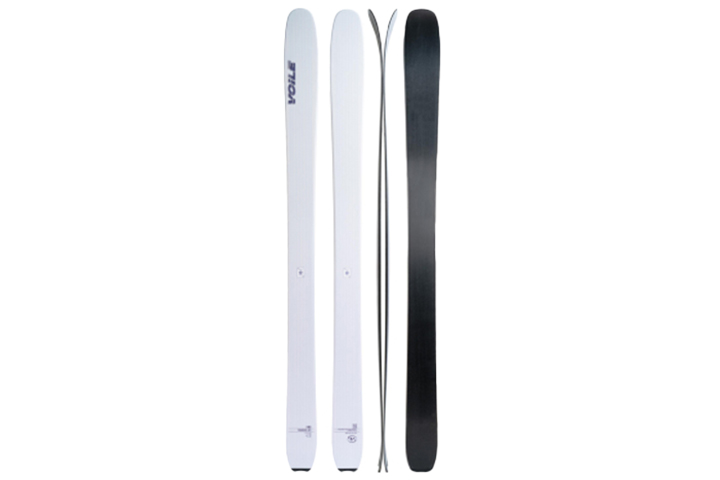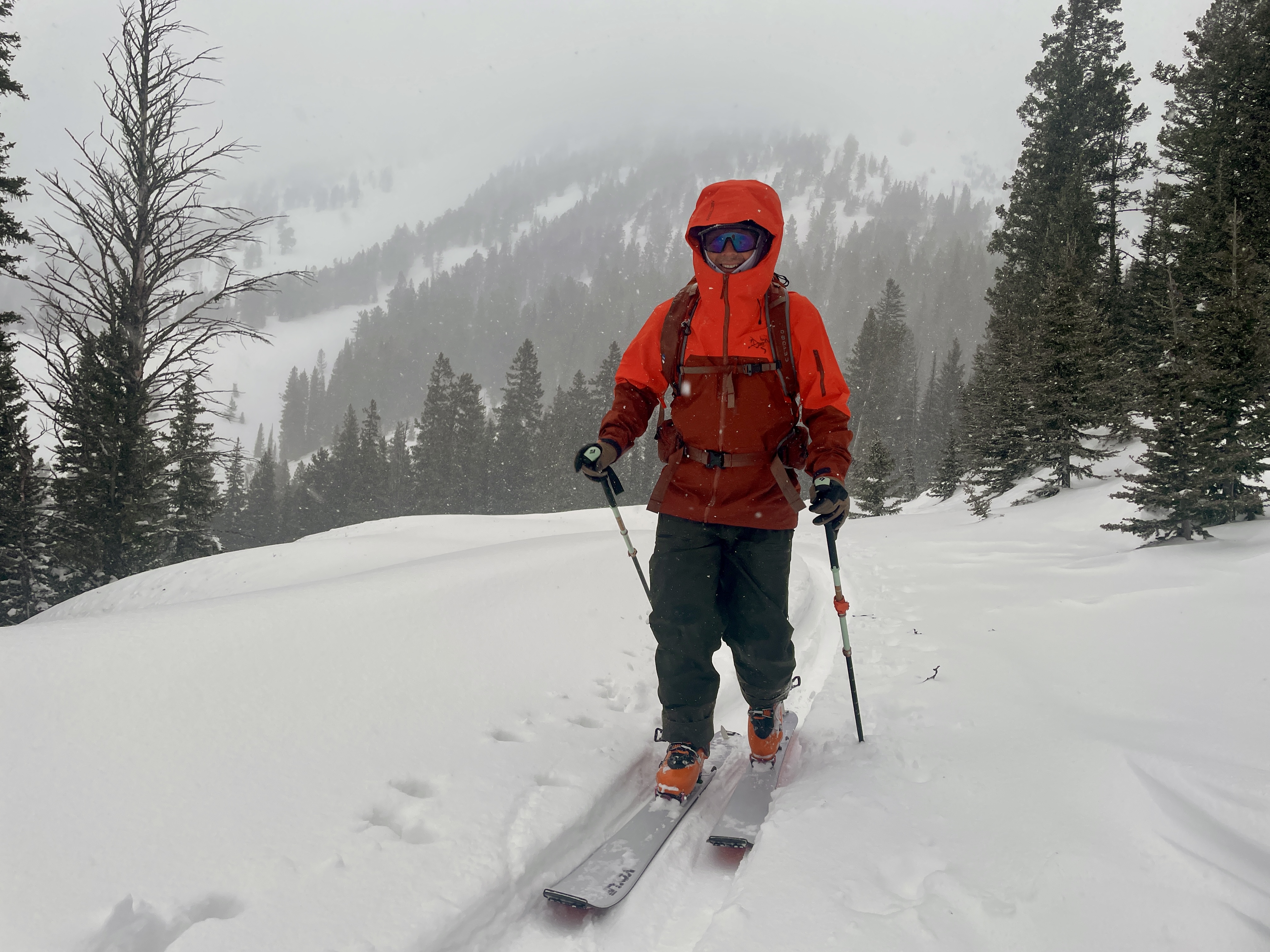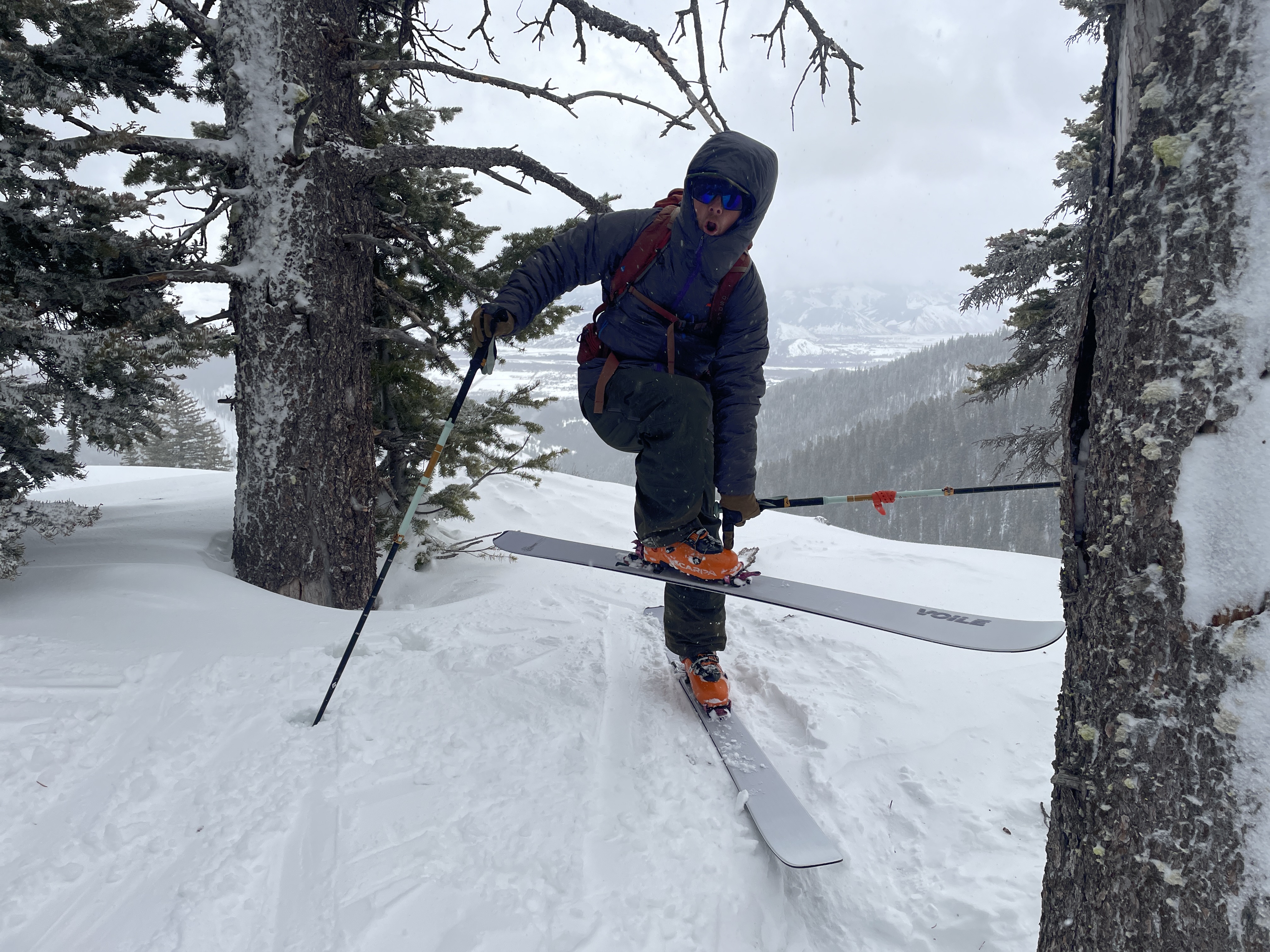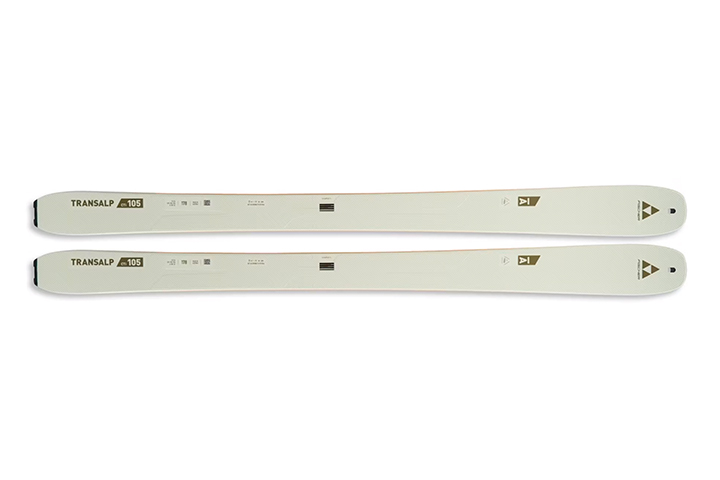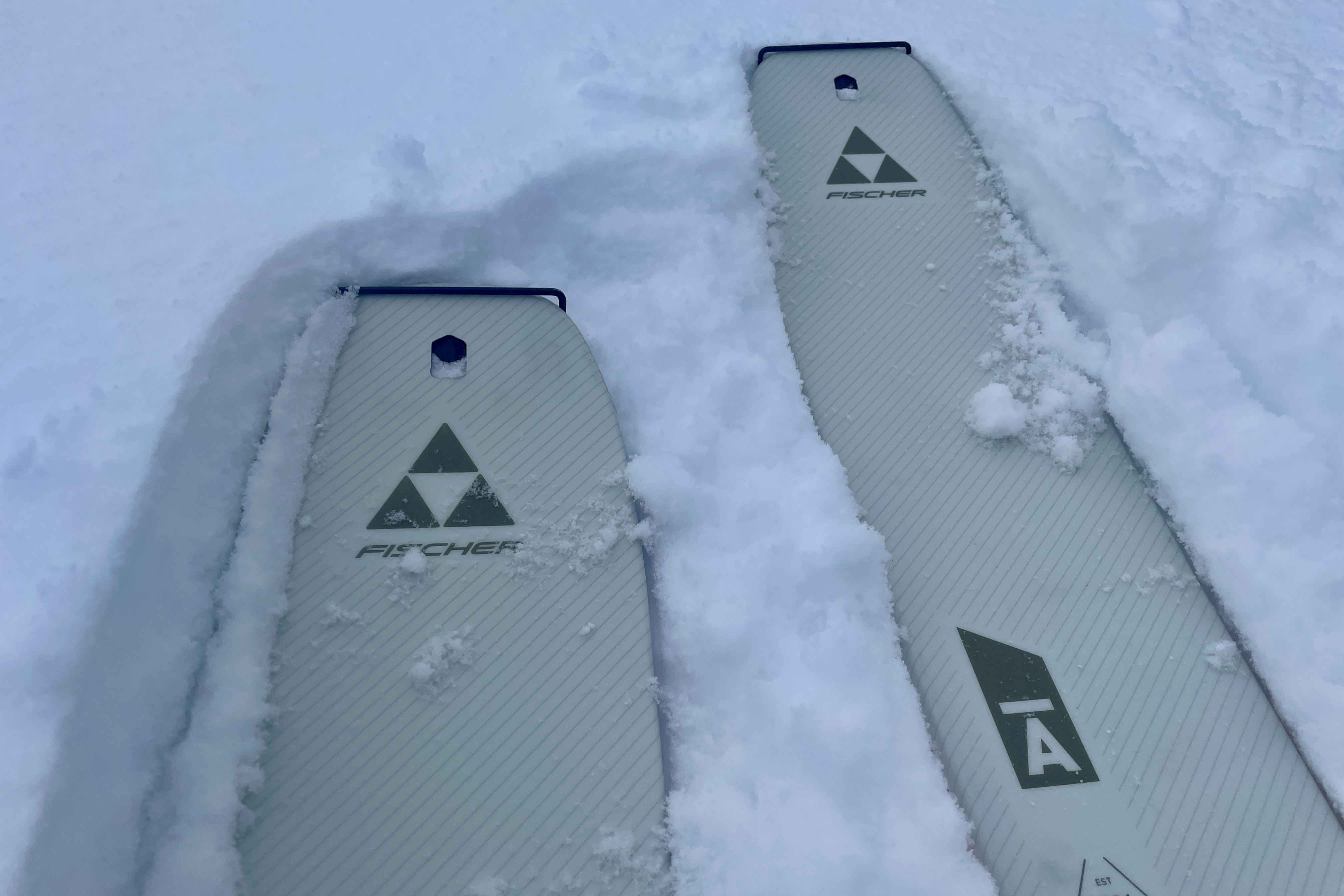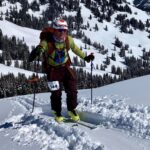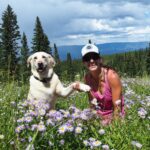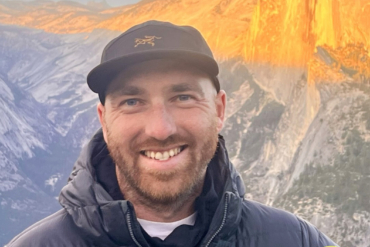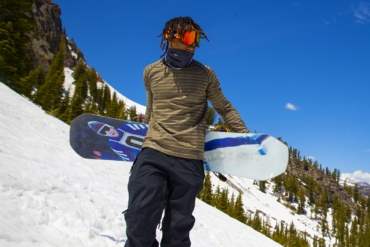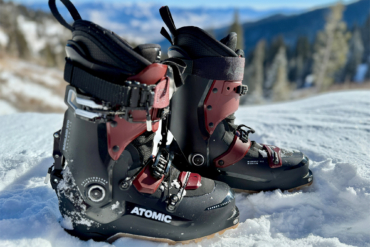When the lift lines end and the skin track begins, your skis become more than gear — they’re your ticket to freedom. The best backcountry skis balance uphill efficiency with downhill confidence. They let you climb higher, charge harder, and adapt to whatever snow the mountains throw at you. From featherweight mountaineering weapons to playful powder surfers, we’ve tested the best to help you find the perfect partner for your next big mission.
We skinned up peaks in Colorado, Vermont, and the Tetons. We dropped into couloirs, danced through tight trees, and cruised mellow glades. And, we even scored a few days of blower pow. Over countless missions in variable conditions, we pushed these skis through powder, ice, windboard, and everything in between.
Along the way, we measured weight, turn radius, profile, and real-world performance. Whether you’re hunting for a budget-friendly workhorse like the Weston Skyline or chasing the precision of a high-end charger like the Atomic Backland 102, this guide will help you find the perfect fit for your style and priorities.
Editor’s Note: We updated this guide on November 10, 2025, adding the Blizzard Zero G 96, our pick for best crossover ski due to its performance in and out of bounds. We also updated our review of each award winner based on further testing.
The Best Backcountry Skis of 2025-2026
Atomic Backland 102
-
Uphill Performance/Weight
9.4
-
Downhill Performance
8.7
-
Versatility
8.8
-
Stability at Speed
8.0
- Lengths: 164 cm, 172 cm, 179 cm, 186 cm
- Weight: 1430 g (179 cm)
- Dimensions: 121/102/130 (179 cm)
- Turn Radius: 19 m (179 cm)
- Core: Poplar/Caruba, ash binding reinforcement, fiberglass laminate
- Best For: One ski quiver for someone who primarily tours
Pros
- Extremely lightweight
- High-energy and playful
- Low carbon emission construction process
- Float extremely well in powder
Cons
- Not good for hard chop and chunder
Weston Skyline
-
Uphill Performance/Weight
6.0
-
Downhill Performance
8.3
-
Versatility
8.7
-
Stability at Speed
7.9
- Lengths: 160 cm, 168 cm, 176 cm, 184 cm
- Weight: 1780 g (176 cm)
- Dimensions: 125/94/111 (176 cm)
- Turn Radius: 17 m (176 cm)
- Core: Poplar and bamboo
- Best For: All-Mountain, steeps, variable conditions
Pros
- Camber makes this ski unique and fun
- One of the most playful skis we tested
- Four-year warranty is one of the longest in the industry
Cons
- Heavier than some other skis
- Sustainability is not a declared focus of the brand
Voile Hyper Manti Skis
-
Uphill Performance/Weight
9.5
-
Downhill Performance
8.5
-
Versatility
8.0
-
Stability at Speed
8.1
- Length: 171 cm, 176 cm, 181 cm, 186 cm
- Weight: 1335 g (176 cm)
- Dimensions: 136/103/123 (176)
- Turn radius: 18 m (176/181 cm)
- Core: Paulownia/Double Carbon
- Best For: Long tours, uphill crushers, powder days and variable conditions
Pros
- Ideal for ultra lightweight touring
- Playful design allows for surfing and maneuverability
- Short turn radius
- Intuitive
Cons
- Tips chatter on hard pack at high speeds
- Mellow top sheet design (but getting better year after year)
Black Diamond Helio Carbon 88
-
Uphill Performance/Weight
9.7
-
Downhill Performance
8.5
-
Versatility
8.0
-
Stability at Speed
7.1
- Lengths: 152 cm, 161 cm, 170, 179 cm
- Weight: 1,290 g (170 cm)
- Dimensions: 120/88/111 (170 cm)
- Turn radius: 18 m (170 cm)
- Core: Paulownia wood
- Best for: High alpine adventures, long-distance tours, technical terrain, fast and light objectives
Pros
- Ultra-lightweight
- Versatile
- Responsive
- Great combo of uphill and downhill performance
Cons
- Chatter on extreme hard pack at high speeds
- Not designed for the deepest days
Atomic Bent Chetler 120
-
Uphill Performance/Weight
7.0
-
Downhill Performance
9.5
-
Versatility
6.0
-
Stability at Speed
9.3
- Lengths: 176 cm, 184 cm, 192 cm
- Weight: 1,800 g (184 cm)
- Dimensions: 143/120/134 (184 cm)
- Turn Radius: 19 m (184 cm)
- Core: Poplar wood
- Best For: Deep powder, storm chasers
Pros
- Cool graphics
- New, more eco-friendly construction
- Surfy and playful
Cons
- Not as versatile as other skis
- For the deepest days only
- Heavy for the uphill
Salomon QST Echo 106
-
Uphill Performance/Weight
6.5
-
Downhill Performance
9.8
-
Versatility
7.0
-
Stability at Speed
9.3
- Lengths: 157, 165, 173, 181, 189 cm
- Weight: 1700 g (173 cm)
- Dimensions: 137/106/125 mm (173 cm)
- Turn radius: 18 m (173 cm)
- Profile: Rocker-Camber-Rocker
- Core: Karuba/poplar wood core
Pros
- Smooth, stable performance in variable conditions
- Excellent float in soft snow
- Confident edge hold and downhill feel
- Lightweight construction with sustainable materials
Cons
- Heavier than some ultralight touring skis
- May be overkill for mellow tours or low-angle terrain
Blizzard Zero G 96
-
Uphill Performance/Weight
8.9
-
Downhill Performance
8.7
-
Versatility
9.0
-
Stability at Speed
8.0
- Lengths: 164 cm, 171 cm, 178 cm, 185 cm
- Weight: 1,110 g (171 cm)
- Dimensions: 127/96/111 mm (171 cm)
- Turn radius 19 m (171 cm):
- Core: Trueblend Touring Core 2.0 – Ultralight paulownia combined with poplar
- Best for: Advanced and expert skiers, downhill chargers, powder touring
Pros
- Smooth and stable for its weight
- Reliable edge hold and damping
- Playful, balanced flex
- Women’s-specific version available
Cons
- Not the lightest touring ski
- Less composed on true boilerplate ice
Other Backcountry Skis To Take You There
-
Uphill Performance/Weight
8.0
-
Downhill Performance
7.0
-
Versatility
8.5
-
Stability at Speed
6.8
- Lengths: 156 cm, 163 cm, 170 cm, 177 cm, 184 cm
- Weight: 1,262 g (170 cm)
- Dimensions: 138/96/119 (170 cm)
- Turn Radius: 20 m (170 cm)
- Core: Hybrid multi-layer wood core
- Best For: Ambitious, advanced, expert or pro skiers
Pros
- Also available in women’s
- Available with pre-cut skins
- Has Volkl’s 3D sidecut
Cons
- Too narrow for West Coast skiers
- Skin system is convenient but didn’t glide as well as others
-
Uphill Performance/Weight
8.3
-
Downhill Performance
6.9
-
Versatility
5.5
-
Stability at Speed
6.5
- Lengths: 160 cm, 168 cm, 176 cm, 184 cm
- Weight: 1,330 g (176 cm)
- Dimensions: 129/95/116 (176 cm)
- Turn Radius: 19 m (176 cm)
- Core: Paulownia
- Best For: Uphill skiers who want freeride performance on the downhills
Pros
- Super light uphill ski that’s fun on descents
- Clever incorporation of Titanal for downhill performance
- Wide range of sizes
Cons
- Doesn’t handle well on ice
- Ski is light and can get pushed around in challenging conditions
-
Uphill Performance/Weight
8.7
-
Downhill Performance
6.9
-
Versatility
6.0
-
Stability at Speed
6.4
- Lengths: 162 cm, 170 cm, 178 cm, 184 cm
- Weight: 1,370g (170 cm)
- Dimensions: 130/95/115 mm (170 cm)
- Turn Radius: 20 m (170 cm)
- Core: Paulownia, beech
- Best for: Expert skiers, big missions where uphill is a priority
Pros
- Light on the uphill and tours exceptionally well
- Great for jump turns
- Tip cutouts for dedicated clip-on skins
Cons
- Can be chattery on hardpack
- All business, less play
- Narrow waist is not the best for powder days
-
Uphill Performance/Weight
5.7
-
Downhill Performance
7.5
-
Versatility
8.5
-
Stability at Speed
7.5
- Lengths: 158 cm, 165 cm, 171 cm, 178 cm, 185 cm
- Weight: 1810 g (185 cm)
- Dimensions: 132/104/123 (185 cm)
- Turn Radius: 19 m (185)
- Core: Carbon, glass ,flax
- Best For: Freetouring freeskiers
Pros
- Great one ski quiver for on-piste & off piste
- Easy to ski
- Broad range of sizes available
Cons
- On the heavy side for a touring ski
- Not as stable as some skis
-
Uphill Performance/Weight
7.0
-
Downhill Performance
7.0
-
Versatility
5.8
-
Stability at Speed
6.7
- Lengths: 157 cm, 164 cm, 171 cm, 177 cm, 183 cm
- Weight: 1,425 g (171 cm)
- Dimensions: 124/99/116 (171 cm)
- Turn Radius: 18m (171 cm)
- Core: Paulownia wood core
- Best for: Backcountry Freeriders
Pros
- Freeride feel
- Come in short lengths
- It’s a ski with attitude
Cons
- Best for soft snow
- Not as versatile as some other skis
-
Uphill Performance/Weight
8.8
-
Downhill Performance
7.0
-
Versatility
6.3
-
Stability at Speed
6.8
- Lengths: 153 cm, 163 cm, 171 cm, 179 cm, 184 cm
- Weight: 1,340 g (171 cm)
- Dimensions: 133/105/117 (171 cm)
- Turn radius: 15 m (171 cm)
- Core: Paulownia
- Best for: Surfy powder turns
Pros
- Exceptional float and playfulness
- Unique short turn radius allows for a fun ride
- Attention to sustainability
Cons
- Expensive
- Not the best in variable conditions
-
Uphill Performance/Weight
8.9
-
Downhill Performance
8.5
-
Versatility
7.3
-
Stability at Speed
7.2
- Lengths: 171, 178, 185 cm
- Weight: 1591 g (178 cm)
- Dimensions: 140-106-124 mm (178 cm)
- Turn radius: 19.5 m (178 cm)
- Core: Paulownia wood core
- Best For: Uphill efficiency, long tours with big vert, powder
Pros
- Ultralight
- Playful and floaty in soft snow
- Nimble and responsive in tight terrain
Cons
- Less stable at speed
- Mediocre edge hold on firm snow
-
Uphill Performance/Weight
7.0
-
Downhill Performance
8.7
-
Versatility
7.0
-
Stability at Speed
7.7
- Lengths: 164, 171, 178, 185 cm
- Weight: 1540 g (178 cm)
- Dimensions: 124/105/139 mm (178 cm)
- Turn radius: 22 m (178 cm)
- Core: Ultralight wood core with Air Tec milling and carbon reinforcement
- Best For: Downhill performance, soft powder turns
Pros
- Stable and predictable in most snow conditions
- Strong edge hold and solid performance in steep terrain
- Lightweight for its width
Cons
- Less stable at high speeds on firm snow
- Can feel twitchy in chopped or crusty snow
Backcountry Skis Comparison Chart
| Backcountry Skis | Price | Weight (per individual ski) | Turn Radius | Best For |
|---|---|---|---|---|
| Atomic Backland 102 | $900 | 1,430 (179 cm) | 19 m (179 cm) | One ski quiver for someone who primarily tours |
| Weston Skyline | $699 | 1,780 g (176 cm) | 17 m (176 cm) | All-Mountain, steeps, variable conditions |
| Voile Hyper Manti | $850 | 1,335 g (176 cm) | 18 m (176/181 cm) | Long tours, uphill crushers, |
| Black Diamond Helio Carbon 88 | $850 | 1290 g (170 cm) | 18 m (170 cm) | High alpine adventures, long-distance tours, technical terrain |
| Atomic Bent Chetler 120 | $850 | 1,800 g (184 cm) | 19 m (184 cm) | Deep powder, storm chasers |
| Salomon QST Echo 106 | $800 | 1700 g (173 cm) | 18 m (173 cm) | Deep Powder, hard charging downhill |
| Blizzard Zero G 96 | $850 | 1100 g (171 cm) | 19 , (171 cm) | |
| Volkl Rise Beyond 96 | $850 | 1,262 g (170 cm) | 20 m (170 cm) | Ambitious, advanced, expert or pro skiers |
| Dynafit Ridge 95 | $800 | 1,330 g (176 cm) | 19 m (176 cm) | Uphill skiers who want freeride performance on the downhills |
| Scott Superguide 95 | $750 | 1,370g (170 cm) | 20 m (170 cm) | Expert skiers, big missions where uphill is a priority |
| Line Vision 104 | $800 | 1,810 g (185 cm) | 19 m (185) | Freetouring freeskiers |
| Faction La Machine 2 Mini | $900 | 1,425 g (171 cm) | 18m (171 cm) | Backcountry Freeriders |
| Black Crows Navis Freebird | $999 | 1,550 g (173 cm) | 18 m (167 cm), 19 m (173 cm), 19 m (179 cm), 19 m (185 cm) Profile Rocker-Camber-Rocker | Poplar, paulownia, carbon/fiberglass |
| DPS Carbon Pagoda Tour CFL 105 | $1,695 | 1,340 g (171 cm) | 15 m (171 cm) | Surfy powder turns |
| Voile Charger ACE | $995 | 1591 g (178 cm) | 19.5 m (178 cm) | Uphill efficiency, long tours with big vert, powder |
| Fischer Transalp CTI 105 | $900 | 1540 g (178 cm) | 22 m (178 cm) | Downhill performance, soft powder turns |
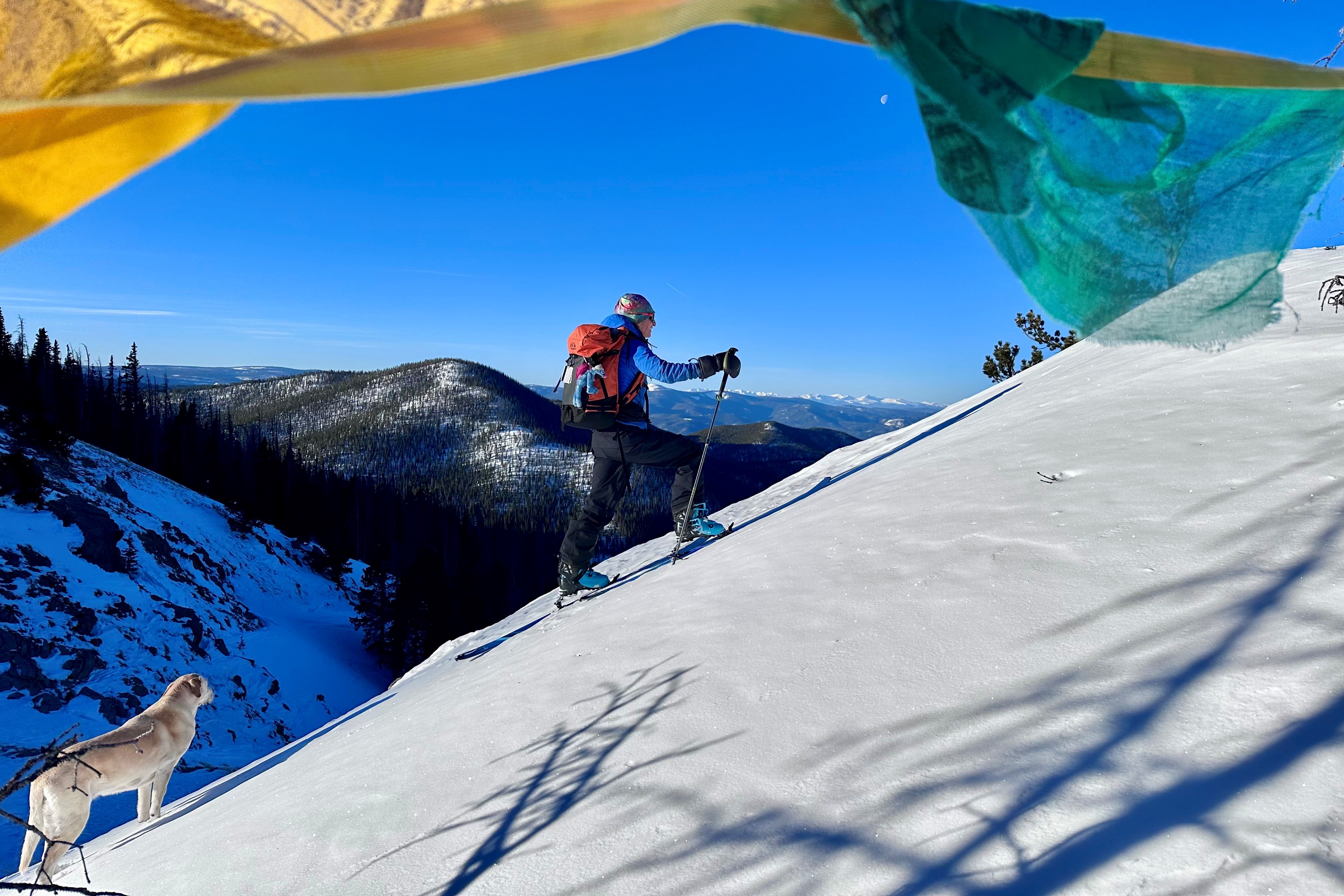
How We Tested The Best Backcountry Skis
Our Expert Testers
Our GearJunkie gear testing team includes skiers from intermediates to experts and professional guides. We have spent decades exploring the backcountry and side country worldwide.
Lead author Berne Broudy is an avid skier who has skinned lines across the U.S. and Canada. She’s also gone on sail and ski expeditions in Norway and Alaska. She put on her skis at Kulusuk Airport in Eastern Greenland and skied from hut to hut. And she’s skied every condition in Iceland.
In 2024, we also added editor Chris Kassar and backcountry enthusiast Ryan Kempfer to the line-up of testers. Ryan has worked in the ski industry for years. Most recently, he was a ski tech and master boot fitter. He loves helping people find the best gear for their ski style. Chris started backcountry skiing seriously in Alaska on Telemark skis in the 90s. She racks up over 100 days a year, mainly in the backcountry. She has explored the mountains of Colorado, Wyoming, and Utah for the last couple of decades.
Our Testing Grounds & Process
From glades to steeps, powder to sastrugi, the Rockies to the Alps, we’ve put these backcountry skis through the wringer. Skis are like snowflakes. Since no two are the same, it makes finding the right ski both a daunting and exciting process.
While assessing which backcountry skis are the best, we evaluated a range of factors. We looked at stiffness, maneuverability, playfulness, energy, damping, chatter, weight, shape, edge hold, and turn initiation. The size, width, base, and edge tune also influence how a ski performs. We considered what type of skier and conditions each ski is best for.
We tested skis in a range of snow conditions, arctic temperatures, blizzards, rain, and the deepest powder days.
Beyond our field tests and personal experience, we considered the most popular and innovative backcountry skis on the market. We sought to include a broad range of price points and applications to serve a range of skiers. Also, check out our guides to the best all-mountain skis and the best cross-country skis.

Our Backcountry Ski Rating System
We evaluate each ski using four main criteria to give a clear picture of its strengths and best uses. Uphill Performance reflects how efficiently a ski climbs, factoring in weight, skintrack grip, and overall touring feel. Downhill Performance measures stability, control, and confidence across a variety of snow types, from powder to refrozen crust. Versatility looks at how well a ski transitions between conditions and terrain, from tight trees to big alpine lines. Stability at Speed focuses on how composed the ski feels when charging down open faces or navigating variable snow.
Note: The Overall Rating is not an average of these numbers. It’s our holistic impression after extended use, combining objective performance metrics with subjective tester feedback.
Backcountry Skis: A Buyer’s Guide
There are a lot of backcountry skis to choose from. It can be challenging to sort through them to find the one that’s best for you. Weight, price, core material, turning radius, rocker and camber — all are ski characteristics that will determine how your ski feels. The best way to find the perfect backcountry ski is to know how and where you’ll ski.
What Type of Skier Are You?
Backcountry skiers generally fall into three main categories: Uphill-focused, downhill-focused, or both. If you ski in deep snow, choose a wider ski. This will maximize your float in powder, like the Bent Chetler 120 or the 4FRNT Hoji 4Lock. A heavier ski will glide through variable snow and grip on the ice better. But, it will likely be slower on the uphill.
If you’re all about ease on the uphill, a lightweight ski like the Voile HyperManti will help you rack up vertical gain. But it may not be as stable or fun on the descent.
Just remember, you may sacrifice a bit of uphill or downhill capability depending on your priorities. That said, there are certainly skis that are great “quiver killers” like the Coalition Snow La Nieve ski. We cover all of those options in this guide.

Backcountry Specific vs. Hybrid Skis
Backcountry-specific skis are often much lighter because you’ll spend more of your time on them walking uphill and less time skiing down. These skis enable us to go further and move more efficiently while saving energy for the downhill. Great pure backcountry-specific choices in the above guide are the Voile Hyper Manti Skis, LaSportiva Tempo, Scott Superguide, Dynafit Ridge 95, and the DPS Carbon Pagoda Tour CFL 105.
Hybrid skis, also known as “50/50” skis, are best used with a hybrid binding like Atomic’s Shift. This setup is ideal for those who plan to ride chairlifts, and/or ski the sidecountry and backcountry. The Blizzard Zero G 96, Black Crows Navis Freebird are a great choice in this realm.
Of course, it’s more expensive to have a quiver of skis meant for different purposes. But as you spend more time in the backcountry, you’ll want backcountry-specific skis.

Ski Length
Once you know what’s important to you, figure out your ski length. The right ski length depends on your height, weight, ability, and preferences.
A 5’10″ 180-pound male should consider a length of around 180 cm for a resort-focused freeride powder ski. A hard-charging expert might opt for a ski closer to 190 cm. A beginner/intermediate might choose a ski in the 170cm range. For a newer skier, shorter skis are more fun and manageable because they’re more nimble and easier to turn. Likewise, some backcountry tree skiers also prefer shorter skis because they’re more agile. The Volkl Rise Beyond 96 and Faction’s LaMachine 2 Mini have an especially good range of sizes that will meet the needs of most skiers.

Waist Width
Ideally, in the backcountry, you’re seeking untracked snow. But you may encounter a whole range of conditions in one day, from deep powder to crust to corn. Skis with 90-105 mm waist width, like Weston’s Skyline and Volkl’s Rise Beyond, are best for skiers who spend half their time on more consolidated snow and half their time in soft snow. Choose a ski with a 105-120 mm waist, like Atomic’s Bent Chetler 120, for powder. If your standard conditions are 6-12 inches of fresh powder, wider skis will give you maximum float.
Our widest ski, the Atomic Bent Chetler 120, has more than enough float for even the deepest of days. At the other end of the spectrum, skis like the Black Diamond Helio Carbon 88, LaSportiva Tempo, the DPS Carbon Pagoda Tour CFL 105, and the Dynafit Ridge cut away all extra weight to make for the fastest and lightest construction for the uphill and big days in the alpine, but they wouldn’t be our top choice on a deep day.
If you opt for a waist above 120, you’re firmly into the big-mountain powder category for special days when you’ll be skiing two feet or more of fresh snow. An over 120mm waist ski is a dream-day quiver ski. Don’t expect to take it out all the time.
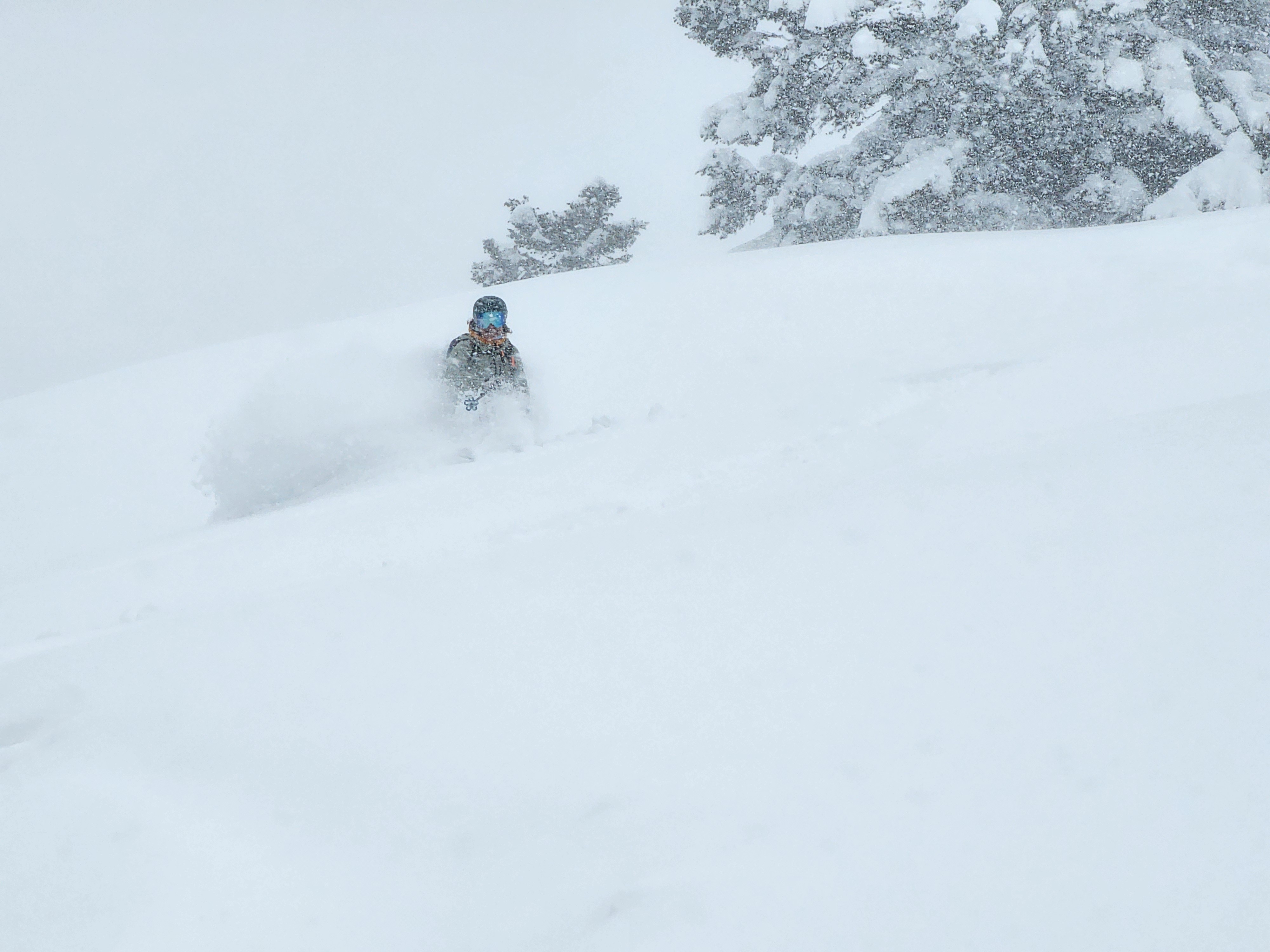
Turn Radius
A ski’s turn radius, which is measured in meters, is based on the sidecut of a ski: the shape of the curve along either side of its length. Most skis have an hourglass shape, but the radius of these curves has a crucial effect on steering, speed, and stability.
Skis that are much wider at the tip and tail than at the waist have a shorter turning radius. A shorter turning radius is great for quick and nimble movements in the trees and moguls. Anything less than 16 meters has a short turning radius.
If you like to carve super-G turns and ski fast, pick a ski with a turn radius over 20 meters, like 4FRNT’s Hoji 4Lock. If you like to make tight turns, look for a ski with a turn radius of 15 m or below, as we see in DPS’s Carbon Pagoda Tour CFL 105. A shorter turn radius will make it easier to ski if you’re a beginner or intermediate. Some skis on the market, like Volkl’s Rise Beyond, have what’s called an adaptive turning radius, which creates a different radius turn intuitively depending on how you engage the turn.
Depending on the length, the sweet spot for the turn radius of a dedicated backcountry ski is often between 17 m and 19 m. A medium turn radius like we see on the Black Diamond Helio 88 skis enables the ski to maintain stability while making big turns without sacrificing nimble maneuverability in tight trees and couloirs.
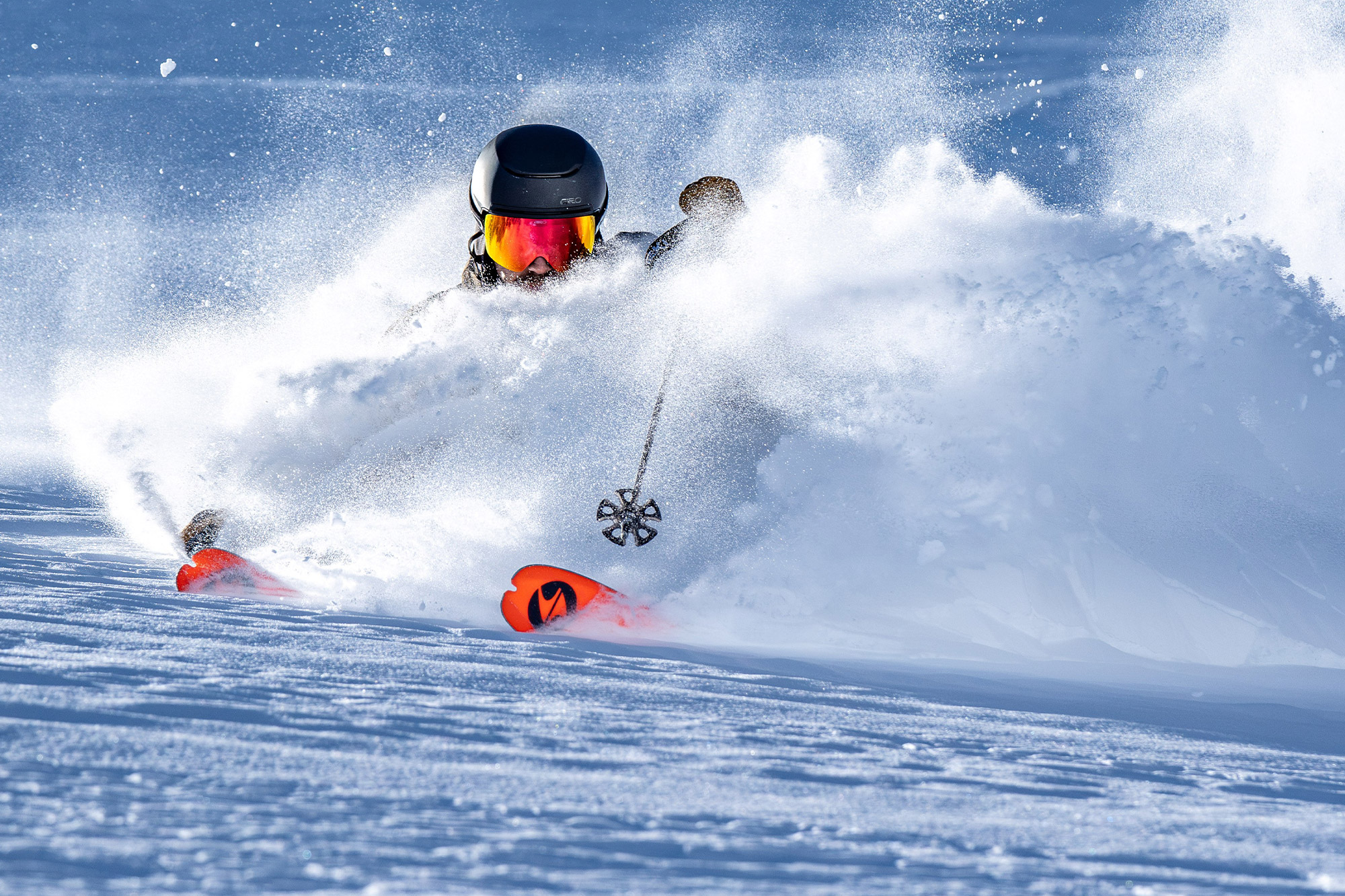
Rocker and Camber
Rocker and camber describe the profile of the ski from tip to tail when viewed from the side. A rockered ski is upturned at the nose and allows for maximum float in powder.
Add camber, which looks like a bow underfoot, and it gives the ski potential energy you engage when you pressure into a turn. As we see in the Atomic Backland 102, camber allows the edges of the ski to “bite” into the snow for better carving, edge hold, and control. Reverse camber looks like a banana from the side and has a surfy feel.
Most all-mountain and backcountry skis use a blend of rocker and camber to make them easier to turn. A ski with rocker in the tip and tail, like the Voile Hyper Manti, is less likely to get caught up in chunky or deep snow. The upturn allows the ski to float through powder, and it offers a more playful, less aggressive feel.
Many skis have a rocker-camber-rocker profile, which makes them good carving and easy to turn. Some also have a flat tail, which gives the ski a “racier” profile for carving longer and more powerful turns without washing out.
Some, like Weston’s Skyline, use a combination of traditional and reverse camber in the tip and tail for a unique ride feel.
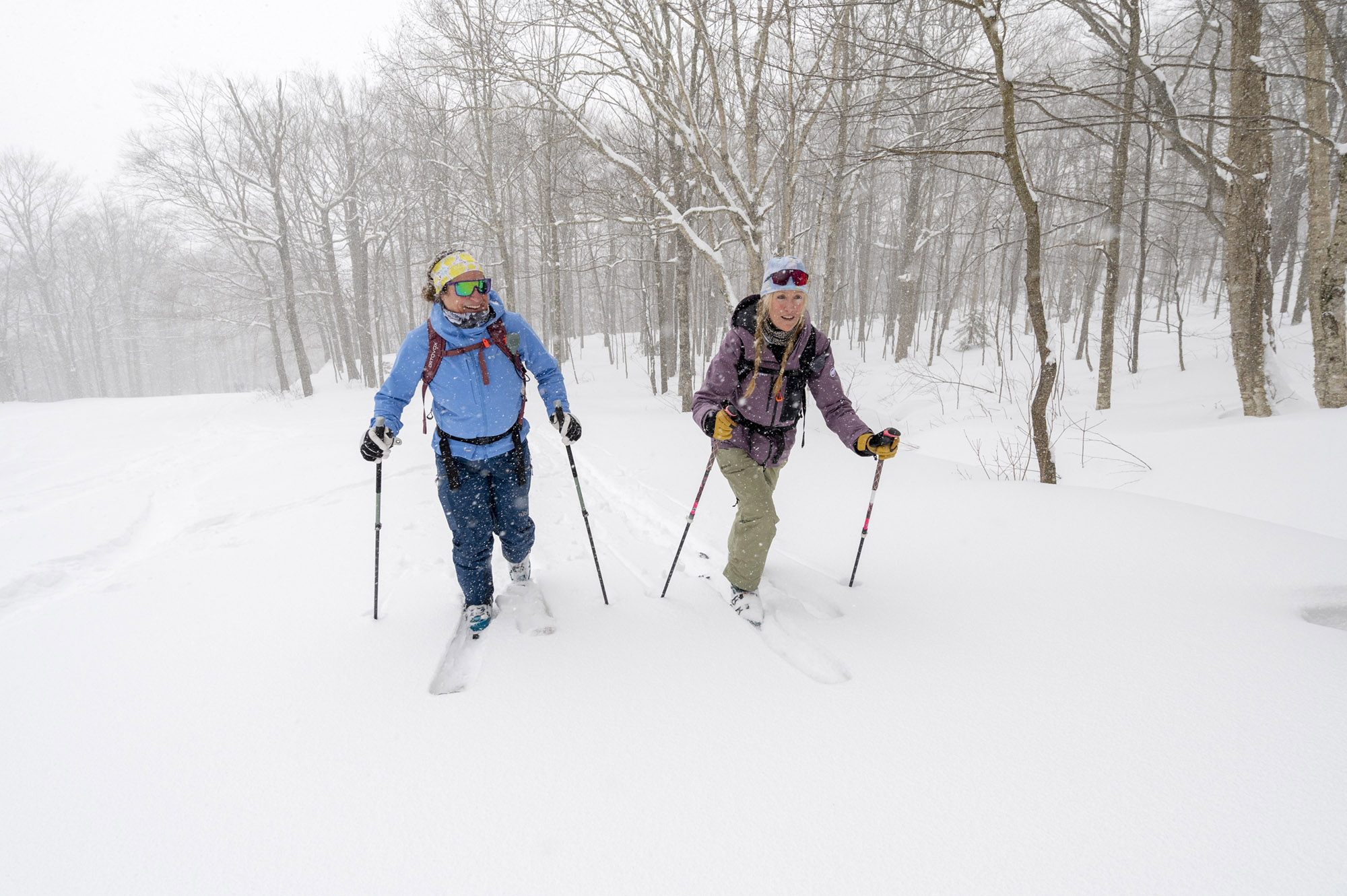
Materials
Most skis are built with a wood core, usually beech, poplar, or aspen. Add metal to the construction, like in the Dynafit Ridge 95, and the ski gains stiffness and stability at speed. But, it also gets notably heavier. Many ski manufacturers strategically integrate carbon around ski cores for metal-like performance enhancements without the weight. For instance, the Black Diamond Helio Carbon 88, LaSportiva Tempo and Blizzard Zero G 96.
Carbon is stiff and light, whether used as a sheet or in strips called “stringers,” like in the DPS Carbon Pagoda Tour CFL 105 or Line’s Vision 104. It’s used in backcountry skis as a lighter alternative to metal with a less aggressive feel. Stiff and light carbon gives a ski grip and saves you energy, but it can be more chattery than metal in hard snow. Some skis add non-traditional materials, like the Line Vision, which uses flax for damping, or the La Sportiva Tempo, which uses D30 to reduce vibration.
Weight
Backcountry skis can range from feather light, like Voile’s 1335g Hyper Manti, to moderately heavy, like the 1990g 4Frnt Hoji 4lock skis. In this roundup, we didn’t include the absolute lightest or definitively heaviest backcountry skis. When skis are too light, they can be chattery or hard to control when descending the mountain. And the heaviest skis can be tiring to haul uphill.
The lightest backcountry skis are usually skimo skis, made for racers who need to get uphill as fast as possible. The heaviest backcountry skis are often alpine skis mounted with a touring binding. However, we tested some, like the Black Diamond Helio Carbon 88 skis, which are ultra-light but still perform well in all but the deepest or iciest conditions thanks to their early rise tips and innovative design.

Width, length, and ski construction all impact weight. So do the bindings you choose. A moderate to heavier ski will do better skiing downhill. Many have metal or carbon inside that can help skiers carve in heavy snow or other challenging conditions. A light ski can get pushed around and may not be as fun skiing downhill.
Skis in the middle, which include all of the skis in this article, are those we typically prefer for our backcountry outings. However, if speed ascending is your top priority, you may be willing to compromise some downhill performance, by choosing a lighter ski like the DPS Carbon Pagoda Tour CFL 105 or the LaSportiva Tempo.
Parts of a Ski
High-quality backcountry skis are complex tools that pack lots of technology into a streamlined package. The physical construction of your skis will define your experience using them.
The parts of a ski that have the most significant effect on performance are the core, laminates, sidewalls, and base.
Core and Laminates
The core of a ski is the innermost material and partly determines its flex and shape. Most backcountry skis feature a wood core made from poplar, aspen, beech, and paulownia, like DPS’ Carbon Pagoda Tour.
Manufacturers tend to use thinner materials in the tip and tail so that those zones can easily flex and thicker materials underfoot where the ski needs to have maximum grip and also retain a binding. Around the core, metal and/or carbon fiber laminates may be added to boost or reduce characteristics such as pop, rigidity, and dampness as needed.
Sidewalls
Sidewalls cover a ski’s outer edges. Generally, they are made from dense plastic that protects the sides of the core layers. In some skis, the top sheet layer may be extended to conceal the edge and serve as the sidewall.
Base
A ski’s base is the surface that comes in direct contact with the snow. There are two kinds of bases: extruded and sintered. Almost all skis use sintered bases. It requires regular waxing and general maintenance, and it’s the best option for consistent long-term performance.

Price & Value
For most of us shopping for skis, price is a consideration. You’ll pay more for skis that are made in the U.S., and for certain ingredients inside the ski, like carbon fiber. Sometimes, cost is more marketing than anything else. Some brands position themselves in a price bracket to appeal to a certain set of customers.
For example, historically, Atomic skis are some of the most affordable, though the 2025 Atomic Backland 102 is on the pricer side. DPS skis are all over $1,000 unless you find a killer sale or buy them used. All DPS skis are made in the USA, and many have pre-preg carbon inside.
Unlike many product categories, skis are available in most price categories. Just because a ski is more affordable doesn’t mean its a lower-quality ski. However, lower-priced skis may not be as versatile as more expensive ones.
Budget
A budget ski ($400-700) will have a simpler construction and use fewer materials, like the wood core Weston Skyline ($699), which uses poplar and bamboo instead of carbon. You’ll find carbon in mid-tier skis like the Voile Hyper Manti ($850) and Black Crows Navis Freebird ($999). Narrower skis — skis under 95mm waist, are frequently $50-100 less than skis that are 103mm and up underfoot. So most 95 underfoot skis cost less than skis that are 109 and 120 underfoot, like Atomic’s Backland 109 and Bent Chetler 120 unless those skis use premium materials.
When it comes to backcountry skis, there are many great skis on the lower end of the price spectrum. But there are few at the bottom end of the budget price range. While there are beginner alpine frontside skis that cost $400, the only backcountry skis in that price range will be skis that have been discounted or pre-owned.
Mid-Tier
Most skis fall in the mid-tier category ($701-1,000), and skis in this category can be made from a variety of materials and for many different use cases. In this price range, you can find width options for different skier preferences, a variety of constructions for groomers, trees, soft snow and hard snow, park and pipe, and all temperatures and weather.
Often, wider skis like Atomic’s Bent Chetler 120 ($850) are in the premium category. Because the Bent 120 is so wide, it uses more materials than narrower skis. It’s a quiver ski for the skier who owns multiple pairs of skis and isn’t likely motivated by a lower price. But Atomic is a brand that tries to keep its skis affordable, so the Bent is in the Mid-tier price range.
Consider stepping up to a mid-tier ski from a budget ski because mid-tier skis generally have more versatility throughout the range of snow conditions. For instance, our top pick, the Atomic Backland 102 ($900), balances uphill and downhill performance in a range of snow conditions, while the Black Diamond Helio Carbon 88 ($850) is made of extremely lightweight materials without sacrificing much in terms of performance.
In the mid-tier price point, manufacturers incorporate more creative rocker and camber profile designs for skiers who are not looking for a traditional ski. Any skier can feel comfortable buying a ski in the mid-tier range for any backcountry ski activity.
Premium
Most premium backcountry skis cost $1,000 and above, including skis like DPS Carbon Pagoda Tour CFL105, a made-in-the-USA ski that uses carbon construction. Some Black Crows skis also fall into this category. Many times premium skis are priced higher to attract a more affluent customer, or to create the illusion that they’re better than lower-priced skis, which is not always true.
What you get with premium pricing is the highest tech and highest-cost combination of materials that minimize weight and maximize performance. Premium skis will use the best materials available in every aspect of construction, including fiberglass or carbon, the burliest and hardest edges, or the lightest weight edges depending on what the ski is made for, and race quality bases that are more durable and faster. Skis with unique construction techniques, like the DPS Carbon Pagoda Tour CFL 105 ($1,695), use bio-based flax and carbon laminate. And custom skis always fall into the premium category.
Customs skis are made specifically for each customer, from construction to graphics. If you’re a skier who wants nothing more than a photo of your favorite mountain range, your pet, or a meaningful drawing or painting on your ski, and you have a very specific idea of how you want your ski to perform, consider buying custom skis. We have had the opportunity to ski a number of pairs of Wagner Custom skis, and while each pair is unique, all of the Wagners we’ve skied we’ve loved.
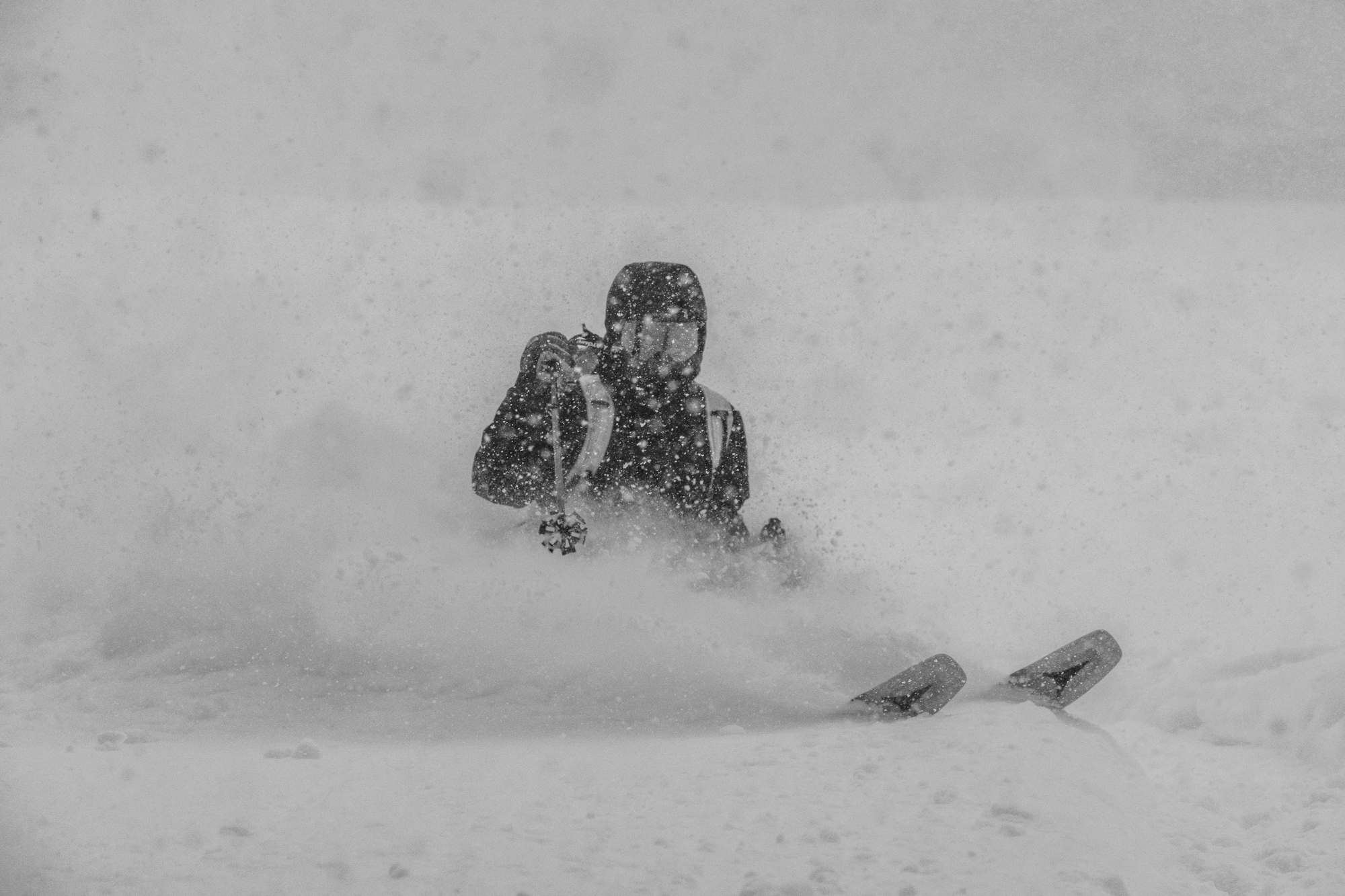
Sustainability
The ski industry is not always the most eco-conscious. Unfortunately, building skis on a large scale is not typically an environmentally friendly process. However, a handful of manufacturers are breaking this trend. More companies are starting to cast aside the old ways and refocus on sustainable and environmentally friendly production methods, incorporating recycled and bio-based materials and nixing chemicals, plastic, and petroleum-based additives.
Local Materials, Solar Power
Several brands have begun sourcing wood locally for their ski cores. Folsom Custom Skis now makes all of its wood cores from responsibly harvested Colorado-sourced trees. DPS and WNDR Alpine have started integrating aspen from near its Salt Lake City production facilities, respectively.
Wagner Skis, a small, custom boutique ski brand based in Telluride, Colo., follows this trend. After a historic avalanche season in 2019, Wagner decided to collect a large amount of deadfall aspen taken down by massive avalanches and recycle them into skis. Wagner also builds all of its skis in a solar-powered facility.
Upcycling Materials
WNDR Alpine is leading the charge as the first ski manufacturer to achieve a negative carbon footprint. They do this, in part, by upcycling materials whenever possible and using the waste materials from building skis to integrate into other skis. Think: using the wood scraps from one pair to make elements of another.

Algal Materials
DPS and WNDR Alpine are also using proprietary algal products and modified tree sap to replace petroleum-based products in its skis. You read that right: algae. These bio-based materials eliminate the need for reliance on petroleum and plastic-based products in production. For instance, read the full review about WNDR’s Nocturne 88 backcountry touring skis that have an algae-based freeride core that’s damp, stable, and energetic.
Both DPS and WNDR Alpine have such a long list of mindful manufacturing practices that we can’t name them all here, from keeping its production in the United States to eliminating plastic wrap for biodegradable materials.
Unfortunately, these practices are generally the exception rather than the norm. The ski industry, to its credit, has come a long way fast in just a few years. But we’ll continue to watch out for these companies going the extra distance to make a positive difference for the environment.
The best part of increased sustainability in skis is that these elements don’t sacrifice — and sometimes even add — performance while also making us feel even better about skiing them. DPS said it best when it noted that its sustainability initiative is rooted in preserving “the art of sliding on snow for future generations.”
Other Essential Gear: Boots, Bindings, and Skins
To get the most out of your time in the backcountry, it’s important to carefully select boots, bindings, and climbing skins that are a good match for your skis, touring style, and skillset.
Backcountry Ski Boots
Match your boot type to your skis’ performance profile. A soft or ultralight boot should pair with an ultralight ski, not a heavy freeride ski.
Like skis, the best backcountry ski boots come with strengths and weaknesses. If the downhill is why you ski, you’ll likely want stiff boots that can handle high speed and hard-charging. Downhill-oriented touring boots are heavier than boots that prioritize uphill performance, and they may have a more limited range of motion while hiking uphill.
If you plan to prioritize uphill efficiency, you’ll want a relatively lightweight boot that feels light on the feet with a wide range of motion when in walk mode. And if you’re looking for one boot for both resort and backcountry skiing, consider buying a hybrid boot that is compatible with alpine ski bindings and hybrid touring bindings. To find the perfect backcountry ski boot for you, check out our guide to the Best Backcountry Ski Boots.
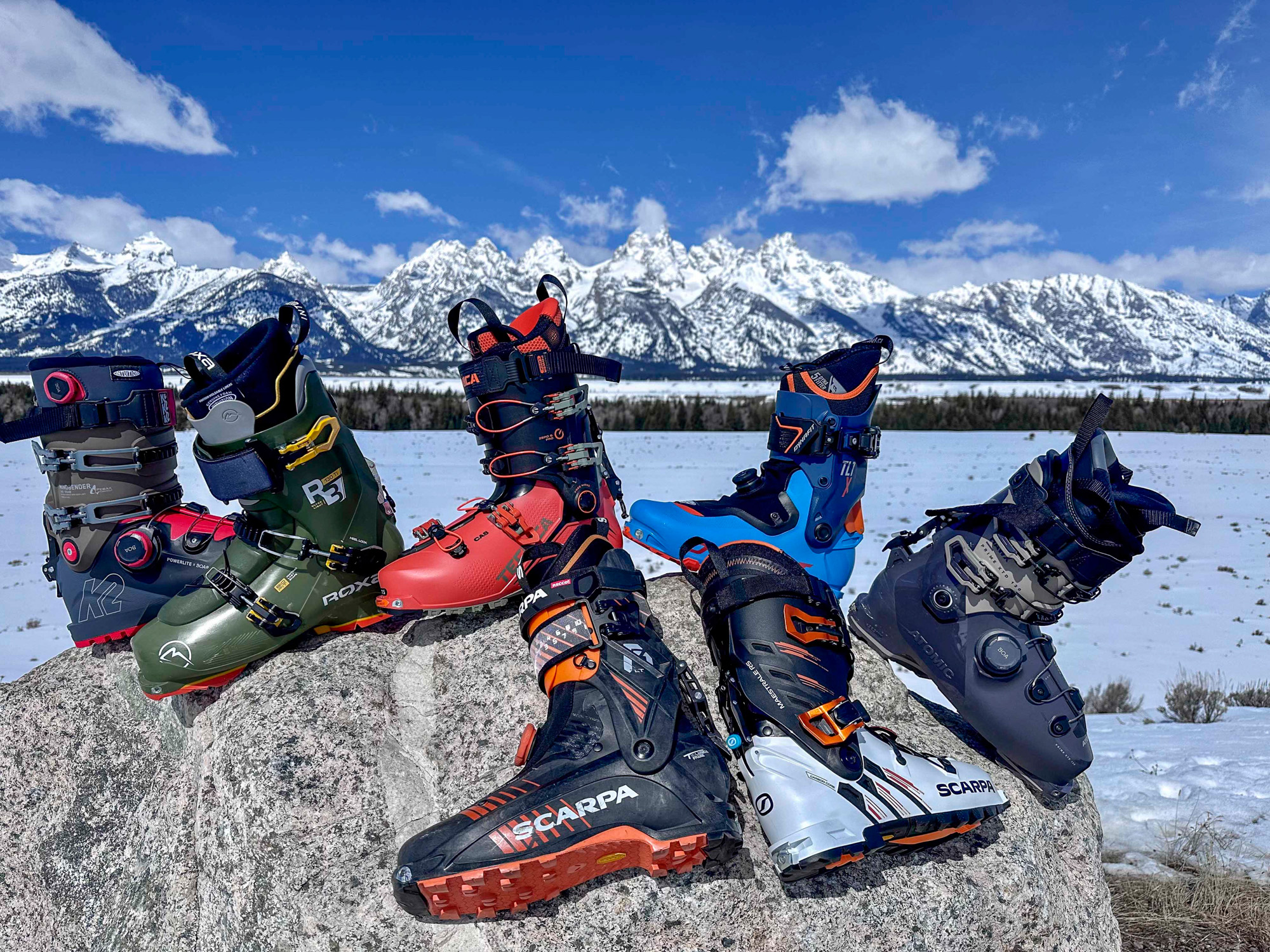
Backcountry Ski Bindings
There are two types of backcountry ski bindings: tech bindings and hybrid bindings. Tech bindings are for light and fast backcountry travel. Hybrid bindings are for backcountry freeriding and extreme skiing. The bindings you choose for your backcountry skis will have a massive influence on how the ski behaves.
To make matters more challenging, there’s an incredibly wide range of options on the market. In order to get the most out of your time in the backcountry, it’s important to carefully select boots and bindings that are a good match for your skis and skillset. Check out our article on the best bindings for the backcountry to find the best option based on your ski priorities and compatibility with your skis and boots.
Climbing Skins
You won’t get very far in the backcountry without your climbing skins, literally. Trust us, we’ve tried (unintentionally). Skins are one of the most underrated pieces of backcountry gear. They are the real behind-the-scenes stars of the show, the ones that are actually getting us up to the top lap after lap. They also quickly have the power to ruin your day if they don’t work as they should, so choose wisely with help from our guide to the Best Climbing Skins.

A Note on Avalanche Safety Education
The mountains are a beautiful and inherently dangerous place — the hazards of backcountry skiing should not be taken lightly.
In order to backcountry ski safely in most places, seek out the proper avalanche safety education before you click into your skis, and if possible, travel with those who are more knowledgeable than you. Choose partners who share your risk tolerance and goals, and seek out experienced mentors. Be sure to carry the proper rescue equipment for each mission and know how to use it well.
We recommend avalanche education courses approved by the American Institute for Avalanche Research and Education (AIARE) and the American Avalanche Institute (AAI). Do not simply depend on an app to keep you safe, though several apps, including OnX Backcountry, Aspect Avy, FATMAP, and CalTopo, can help you navigate the backcountry and its hazards.
Choosing the right skis is a small piece of a large, complex puzzle — as many of you already know, especially if you’ve been out there playing the game.
Essential Avalanche Equipment
If you’re skiing in the backcountry, there’s a lengthy checklist of equipment that you should take with you. An avalanche beacon, probe, shovel, and backpack are mandatory for skiing in avalanche terrain.
We also never head out into the backcountry without proper clothing, extra insulating layers, plenty of snacks, a hot drink in an insulated water bottle, a way to navigate, a repair kit, ski straps, a first aid kit, and knowledge of how to use all of this important gear. These all should be stashed in an appropriately sized, backcountry-specific pack — we like something in the 25-40L range (check out our list of our favorite packs for the backcountry).
Before heading out the door, be sure to check both the weather and avalanche forecast, and be well-prepared for the conditions that you’ll encounter. If you’re not prepared, don’t go.
Additional Backcountry Education
Once you’ve taken your recreational Level One course, you should seek out wilderness first aid or wilderness first responder training and a CPR course so that you can respond to incidents in the backcountry and help your group be self-sufficient. These courses provide an essential baseline of knowledge that could help you save your ski partner’s life in the case of an emergency, like an avalanche.
Have maps downloaded on your phone when you head out so you know where you are. A ski app that shows you slope angles can help you find your way out of a challenging situation or confirm that you’re on the right track for your preferred route.
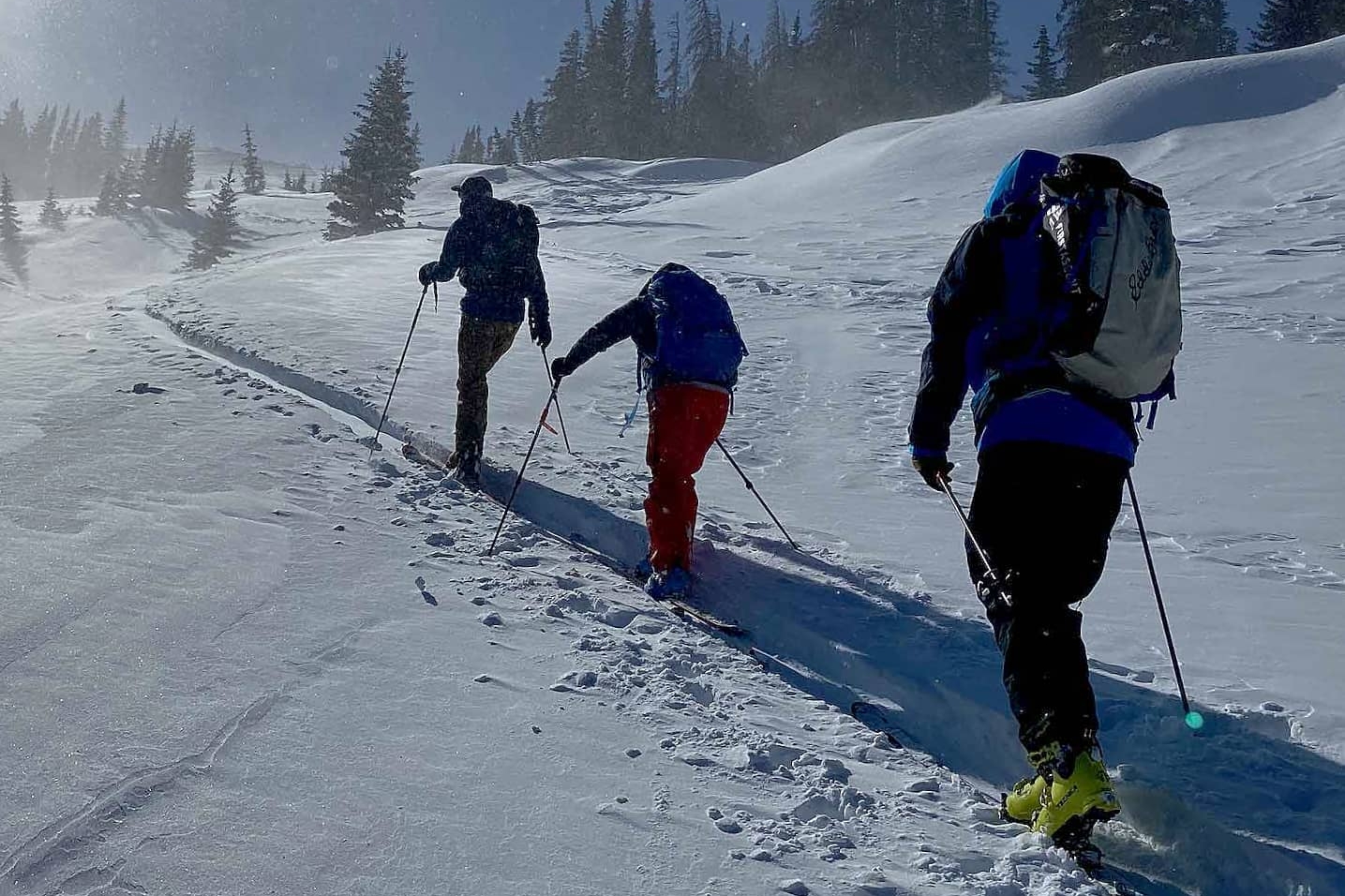
Frequently Asked Questions
In many ways, backcountry skis are a hybrid between their downhill and cross-country counterparts. Because backcountry skiing involves both uphill and downhill travel, backcountry skis must be able to perform well in a wide variety of terrain.
Backcountry skis are typically outfitted with tech bindings or frame bindings, which allow skiers to maneuver on flat and uphill terrain. Additionally, backcountry skis use another piece of gear known as skins to prevent them from sliding backward when traveling uphill.
While downhill skis can work for the uphill when integrated with the right boots and bindings, backcountry-specific skis are definitely your best bet due to their specialized design and lightened-up profile.
Beginner backcountry skiers will want a ski that is properly sized, maneuverable, and progression-oriented. Generally, beginners should avoid skis on the extreme ends of any spectrum. In other words, don’t go for the widest powder ski or the ultralight mountaineering ski, or an aggressive super-stiff ski.
Beginners will benefit from middle-ground do-it-all skis that can be used to experiment, grow, and find your groove in various scenarios.
In short: Yes! Remember that for every foot of vertical you get to ski downhill in the backcountry, you have to earn it on the uphill. Many backcountry skiers ignore the weight of the ski for the sake of performance (or graphics), which ultimately will limit what you’re able to accomplish in the mountains.

The Best Backcountry Ski Bindings of 2025
We tested the best backcountry ski bindings, including top picks from Salomon, Dynafit, Atomic, ATK, and more.
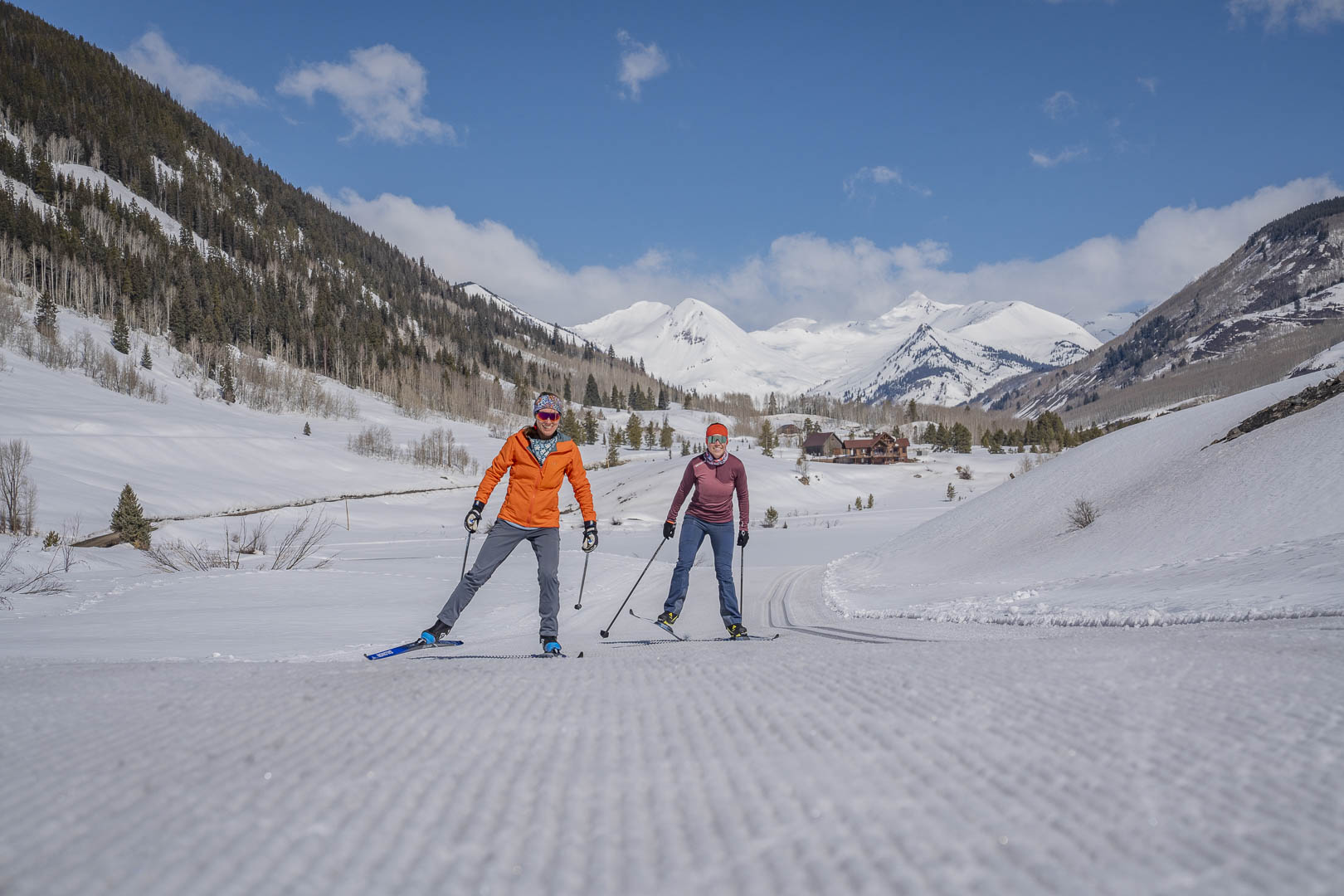
The Best Cross-Country Skis of 2025
We tested the best cross-country skis from Atomic, Rossignol, Salomon, and more to help you find the best option for your needs and budget.

